Strategic Human Resource Management (SHRM) Theory 2022
VerifiedAdded on 2022/09/27
|19
|4453
|24
AI Summary
Contribute Materials
Your contribution can guide someone’s learning journey. Share your
documents today.
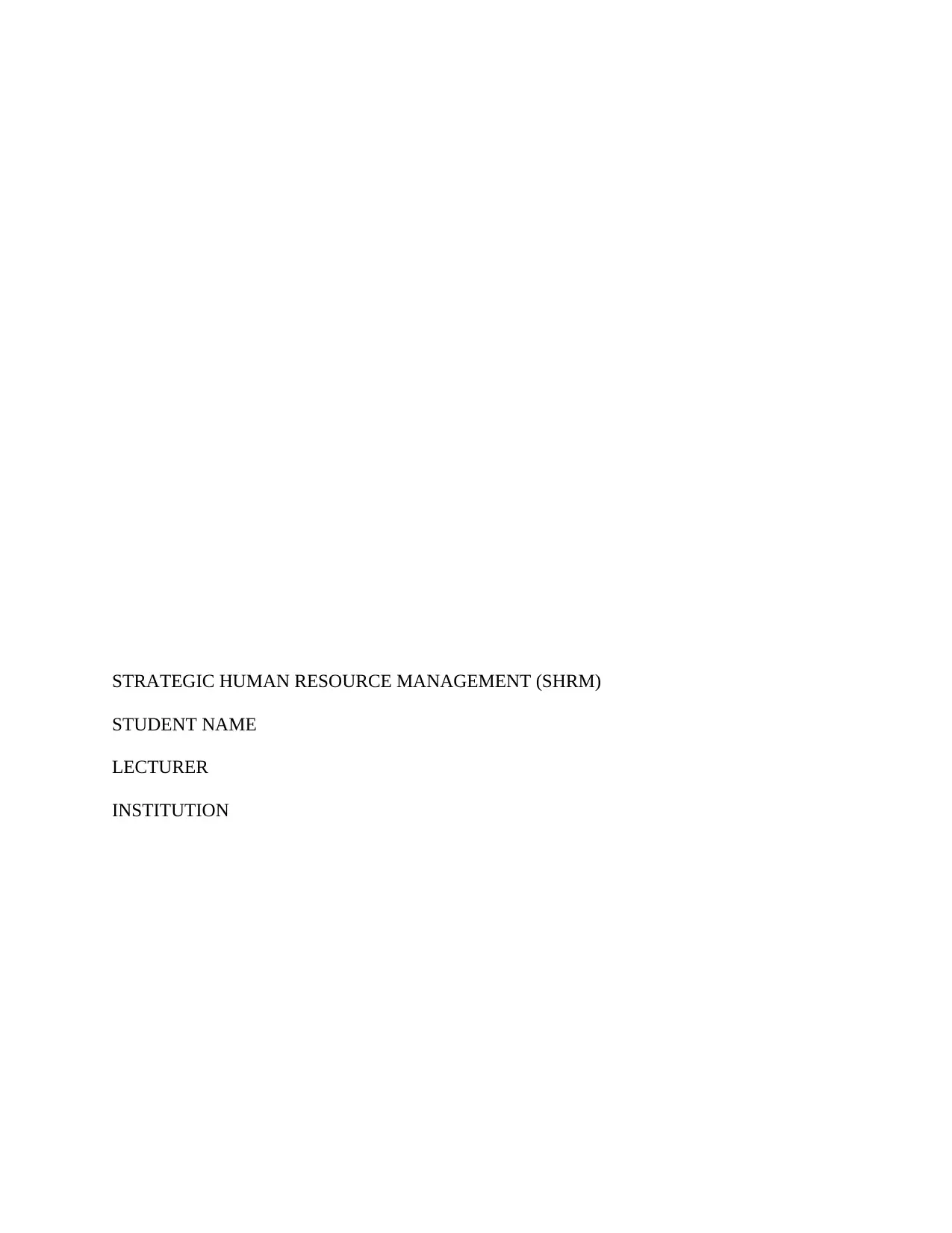
STRATEGIC HUMAN RESOURCE MANAGEMENT (SHRM)
STUDENT NAME
LECTURER
INSTITUTION
STUDENT NAME
LECTURER
INSTITUTION
Secure Best Marks with AI Grader
Need help grading? Try our AI Grader for instant feedback on your assignments.
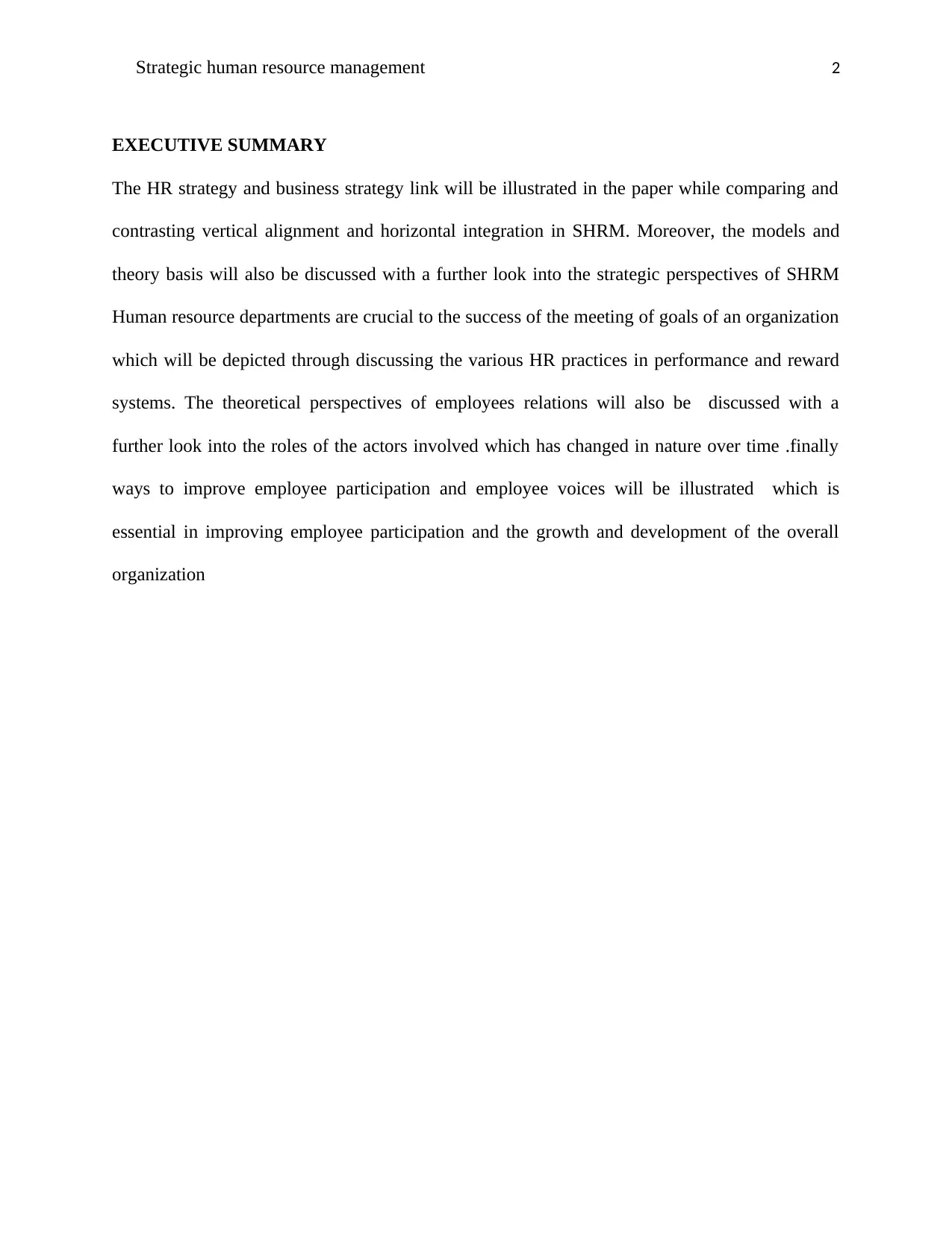
Strategic human resource management 2
EXECUTIVE SUMMARY
The HR strategy and business strategy link will be illustrated in the paper while comparing and
contrasting vertical alignment and horizontal integration in SHRM. Moreover, the models and
theory basis will also be discussed with a further look into the strategic perspectives of SHRM
Human resource departments are crucial to the success of the meeting of goals of an organization
which will be depicted through discussing the various HR practices in performance and reward
systems. The theoretical perspectives of employees relations will also be discussed with a
further look into the roles of the actors involved which has changed in nature over time .finally
ways to improve employee participation and employee voices will be illustrated which is
essential in improving employee participation and the growth and development of the overall
organization
EXECUTIVE SUMMARY
The HR strategy and business strategy link will be illustrated in the paper while comparing and
contrasting vertical alignment and horizontal integration in SHRM. Moreover, the models and
theory basis will also be discussed with a further look into the strategic perspectives of SHRM
Human resource departments are crucial to the success of the meeting of goals of an organization
which will be depicted through discussing the various HR practices in performance and reward
systems. The theoretical perspectives of employees relations will also be discussed with a
further look into the roles of the actors involved which has changed in nature over time .finally
ways to improve employee participation and employee voices will be illustrated which is
essential in improving employee participation and the growth and development of the overall
organization
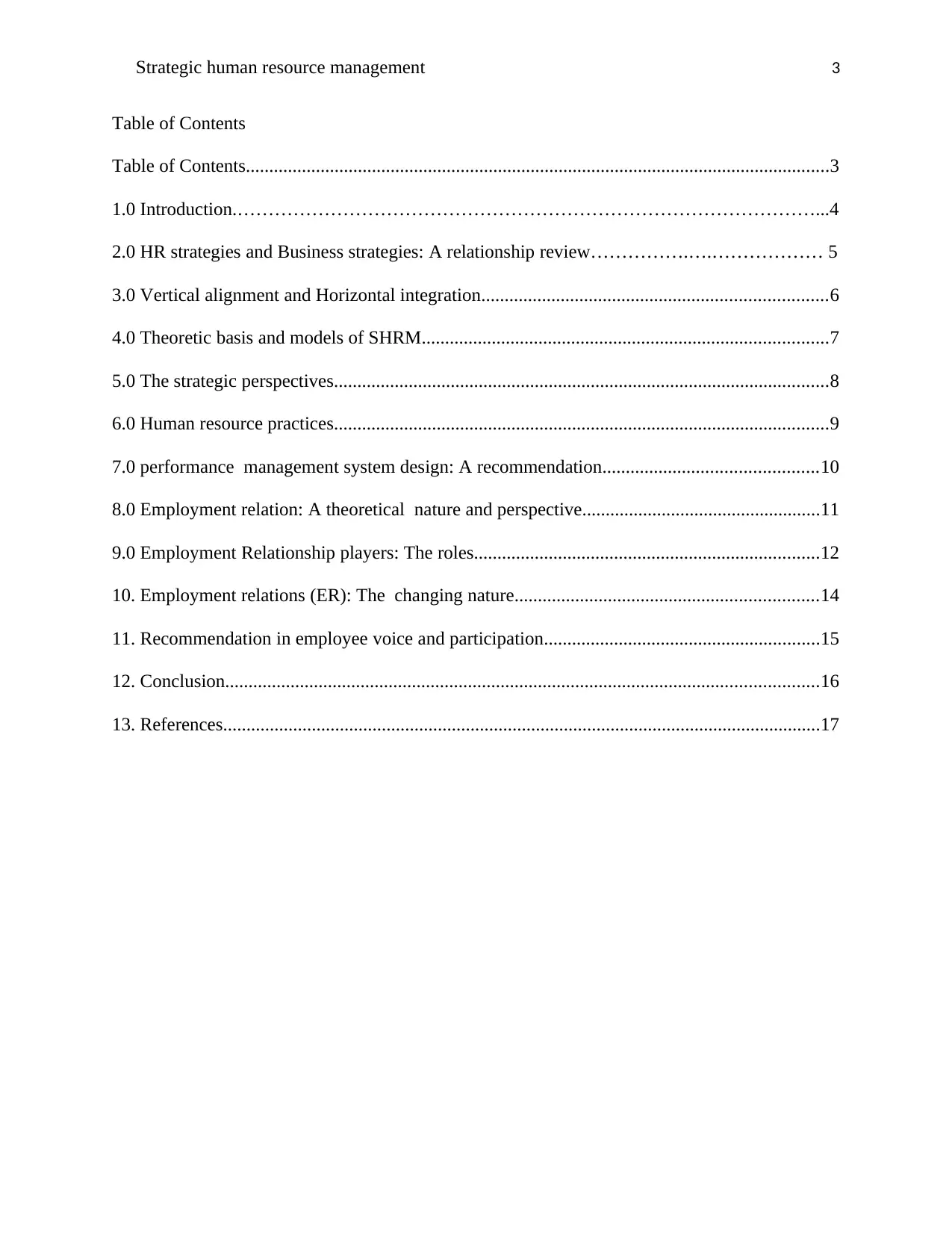
Strategic human resource management 3
Table of Contents
Table of Contents.............................................................................................................................3
1.0 Introduction.…………………………………………………………………………………...4
2.0 HR strategies and Business strategies: A relationship review…………….….……………… 5
3.0 Vertical alignment and Horizontal integration..........................................................................6
4.0 Theoretic basis and models of SHRM.......................................................................................7
5.0 The strategic perspectives..........................................................................................................8
6.0 Human resource practices..........................................................................................................9
7.0 performance management system design: A recommendation..............................................10
8.0 Employment relation: A theoretical nature and perspective...................................................11
9.0 Employment Relationship players: The roles..........................................................................12
10. Employment relations (ER): The changing nature.................................................................14
11. Recommendation in employee voice and participation...........................................................15
12. Conclusion...............................................................................................................................16
13. References................................................................................................................................17
Table of Contents
Table of Contents.............................................................................................................................3
1.0 Introduction.…………………………………………………………………………………...4
2.0 HR strategies and Business strategies: A relationship review…………….….……………… 5
3.0 Vertical alignment and Horizontal integration..........................................................................6
4.0 Theoretic basis and models of SHRM.......................................................................................7
5.0 The strategic perspectives..........................................................................................................8
6.0 Human resource practices..........................................................................................................9
7.0 performance management system design: A recommendation..............................................10
8.0 Employment relation: A theoretical nature and perspective...................................................11
9.0 Employment Relationship players: The roles..........................................................................12
10. Employment relations (ER): The changing nature.................................................................14
11. Recommendation in employee voice and participation...........................................................15
12. Conclusion...............................................................................................................................16
13. References................................................................................................................................17
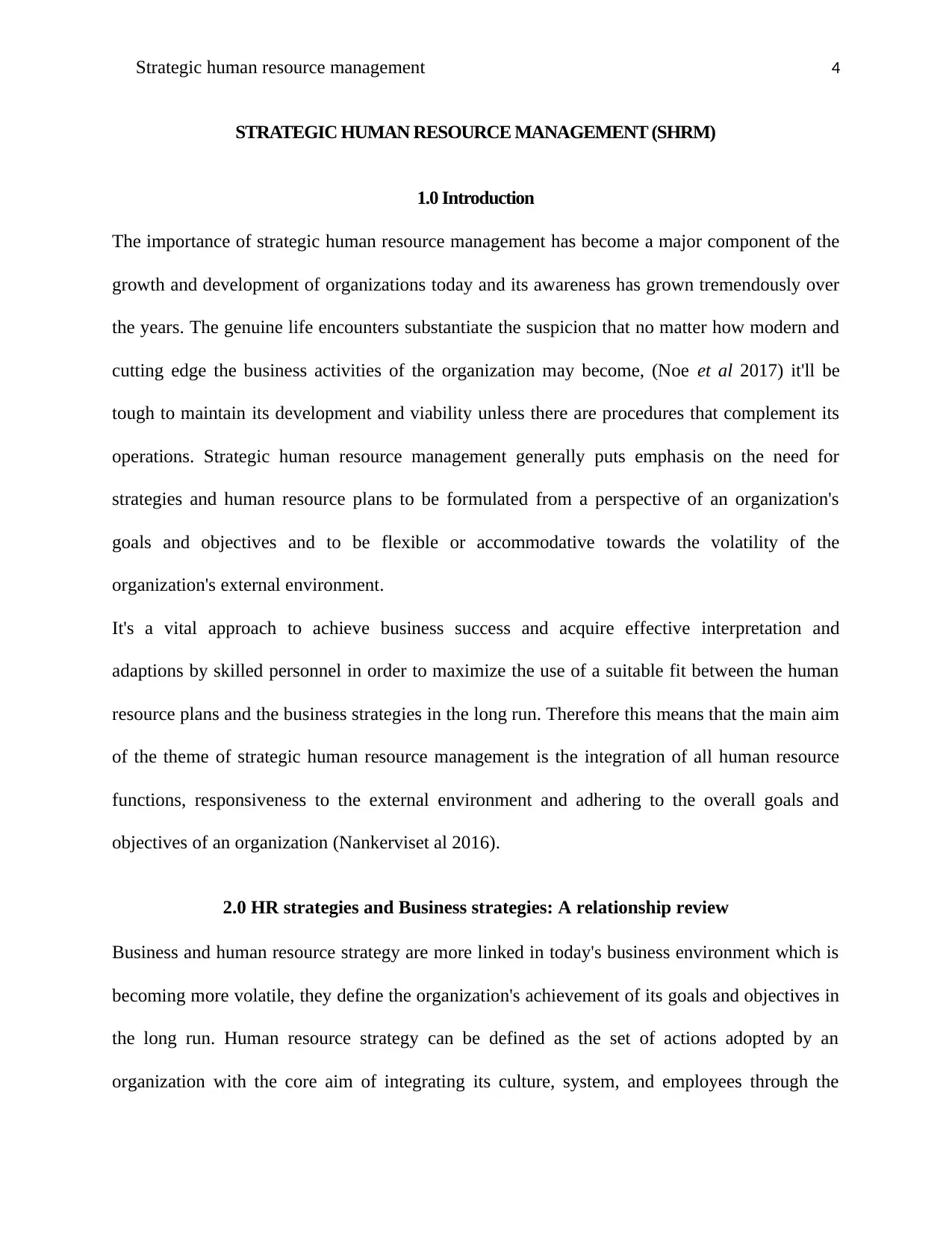
Strategic human resource management 4
STRATEGIC HUMAN RESOURCE MANAGEMENT (SHRM)
1.0 Introduction
The importance of strategic human resource management has become a major component of the
growth and development of organizations today and its awareness has grown tremendously over
the years. The genuine life encounters substantiate the suspicion that no matter how modern and
cutting edge the business activities of the organization may become, (Noe et al 2017) it'll be
tough to maintain its development and viability unless there are procedures that complement its
operations. Strategic human resource management generally puts emphasis on the need for
strategies and human resource plans to be formulated from a perspective of an organization's
goals and objectives and to be flexible or accommodative towards the volatility of the
organization's external environment.
It's a vital approach to achieve business success and acquire effective interpretation and
adaptions by skilled personnel in order to maximize the use of a suitable fit between the human
resource plans and the business strategies in the long run. Therefore this means that the main aim
of the theme of strategic human resource management is the integration of all human resource
functions, responsiveness to the external environment and adhering to the overall goals and
objectives of an organization (Nankerviset al 2016).
2.0 HR strategies and Business strategies: A relationship review
Business and human resource strategy are more linked in today's business environment which is
becoming more volatile, they define the organization's achievement of its goals and objectives in
the long run. Human resource strategy can be defined as the set of actions adopted by an
organization with the core aim of integrating its culture, system, and employees through the
STRATEGIC HUMAN RESOURCE MANAGEMENT (SHRM)
1.0 Introduction
The importance of strategic human resource management has become a major component of the
growth and development of organizations today and its awareness has grown tremendously over
the years. The genuine life encounters substantiate the suspicion that no matter how modern and
cutting edge the business activities of the organization may become, (Noe et al 2017) it'll be
tough to maintain its development and viability unless there are procedures that complement its
operations. Strategic human resource management generally puts emphasis on the need for
strategies and human resource plans to be formulated from a perspective of an organization's
goals and objectives and to be flexible or accommodative towards the volatility of the
organization's external environment.
It's a vital approach to achieve business success and acquire effective interpretation and
adaptions by skilled personnel in order to maximize the use of a suitable fit between the human
resource plans and the business strategies in the long run. Therefore this means that the main aim
of the theme of strategic human resource management is the integration of all human resource
functions, responsiveness to the external environment and adhering to the overall goals and
objectives of an organization (Nankerviset al 2016).
2.0 HR strategies and Business strategies: A relationship review
Business and human resource strategy are more linked in today's business environment which is
becoming more volatile, they define the organization's achievement of its goals and objectives in
the long run. Human resource strategy can be defined as the set of actions adopted by an
organization with the core aim of integrating its culture, system, and employees through the
Secure Best Marks with AI Grader
Need help grading? Try our AI Grader for instant feedback on your assignments.
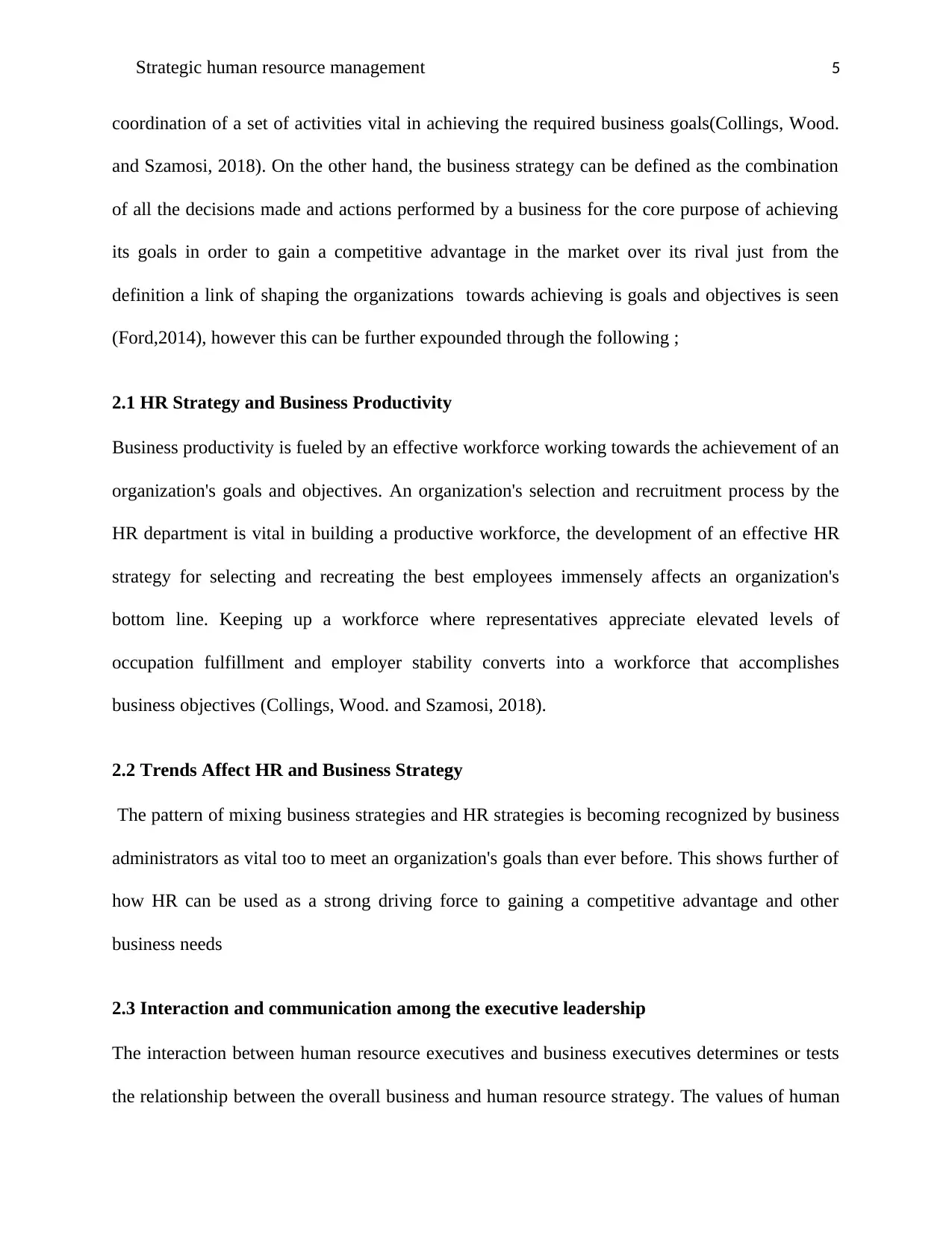
Strategic human resource management 5
coordination of a set of activities vital in achieving the required business goals(Collings, Wood.
and Szamosi, 2018). On the other hand, the business strategy can be defined as the combination
of all the decisions made and actions performed by a business for the core purpose of achieving
its goals in order to gain a competitive advantage in the market over its rival just from the
definition a link of shaping the organizations towards achieving is goals and objectives is seen
(Ford,2014), however this can be further expounded through the following ;
2.1 HR Strategy and Business Productivity
Business productivity is fueled by an effective workforce working towards the achievement of an
organization's goals and objectives. An organization's selection and recruitment process by the
HR department is vital in building a productive workforce, the development of an effective HR
strategy for selecting and recreating the best employees immensely affects an organization's
bottom line. Keeping up a workforce where representatives appreciate elevated levels of
occupation fulfillment and employer stability converts into a workforce that accomplishes
business objectives (Collings, Wood. and Szamosi, 2018).
2.2 Trends Affect HR and Business Strategy
The pattern of mixing business strategies and HR strategies is becoming recognized by business
administrators as vital too to meet an organization's goals than ever before. This shows further of
how HR can be used as a strong driving force to gaining a competitive advantage and other
business needs
2.3 Interaction and communication among the executive leadership
The interaction between human resource executives and business executives determines or tests
the relationship between the overall business and human resource strategy. The values of human
coordination of a set of activities vital in achieving the required business goals(Collings, Wood.
and Szamosi, 2018). On the other hand, the business strategy can be defined as the combination
of all the decisions made and actions performed by a business for the core purpose of achieving
its goals in order to gain a competitive advantage in the market over its rival just from the
definition a link of shaping the organizations towards achieving is goals and objectives is seen
(Ford,2014), however this can be further expounded through the following ;
2.1 HR Strategy and Business Productivity
Business productivity is fueled by an effective workforce working towards the achievement of an
organization's goals and objectives. An organization's selection and recruitment process by the
HR department is vital in building a productive workforce, the development of an effective HR
strategy for selecting and recreating the best employees immensely affects an organization's
bottom line. Keeping up a workforce where representatives appreciate elevated levels of
occupation fulfillment and employer stability converts into a workforce that accomplishes
business objectives (Collings, Wood. and Szamosi, 2018).
2.2 Trends Affect HR and Business Strategy
The pattern of mixing business strategies and HR strategies is becoming recognized by business
administrators as vital too to meet an organization's goals than ever before. This shows further of
how HR can be used as a strong driving force to gaining a competitive advantage and other
business needs
2.3 Interaction and communication among the executive leadership
The interaction between human resource executives and business executives determines or tests
the relationship between the overall business and human resource strategy. The values of human
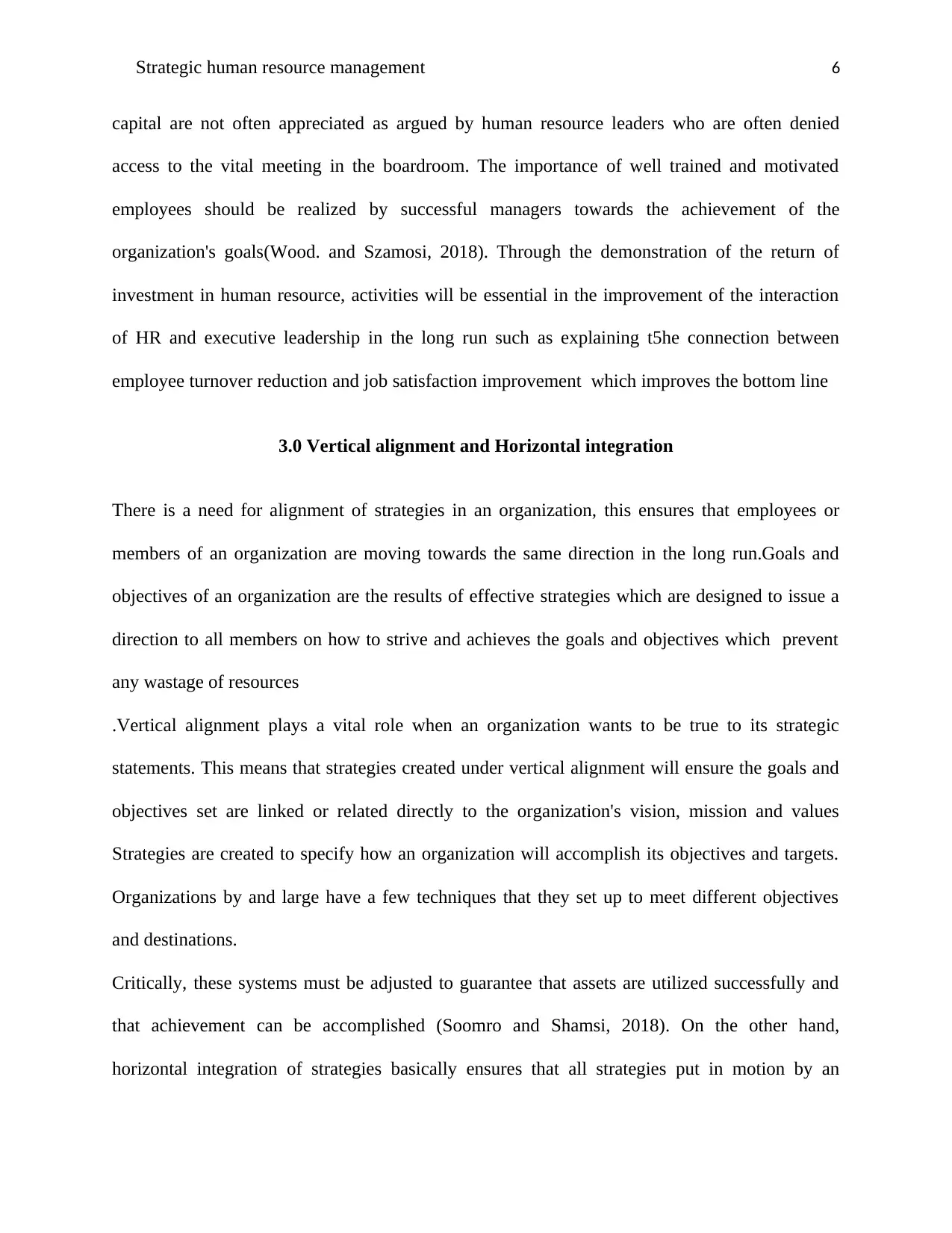
Strategic human resource management 6
capital are not often appreciated as argued by human resource leaders who are often denied
access to the vital meeting in the boardroom. The importance of well trained and motivated
employees should be realized by successful managers towards the achievement of the
organization's goals(Wood. and Szamosi, 2018). Through the demonstration of the return of
investment in human resource, activities will be essential in the improvement of the interaction
of HR and executive leadership in the long run such as explaining t5he connection between
employee turnover reduction and job satisfaction improvement which improves the bottom line
3.0 Vertical alignment and Horizontal integration
There is a need for alignment of strategies in an organization, this ensures that employees or
members of an organization are moving towards the same direction in the long run.Goals and
objectives of an organization are the results of effective strategies which are designed to issue a
direction to all members on how to strive and achieves the goals and objectives which prevent
any wastage of resources
.Vertical alignment plays a vital role when an organization wants to be true to its strategic
statements. This means that strategies created under vertical alignment will ensure the goals and
objectives set are linked or related directly to the organization's vision, mission and values
Strategies are created to specify how an organization will accomplish its objectives and targets.
Organizations by and large have a few techniques that they set up to meet different objectives
and destinations.
Critically, these systems must be adjusted to guarantee that assets are utilized successfully and
that achievement can be accomplished (Soomro and Shamsi, 2018). On the other hand,
horizontal integration of strategies basically ensures that all strategies put in motion by an
capital are not often appreciated as argued by human resource leaders who are often denied
access to the vital meeting in the boardroom. The importance of well trained and motivated
employees should be realized by successful managers towards the achievement of the
organization's goals(Wood. and Szamosi, 2018). Through the demonstration of the return of
investment in human resource, activities will be essential in the improvement of the interaction
of HR and executive leadership in the long run such as explaining t5he connection between
employee turnover reduction and job satisfaction improvement which improves the bottom line
3.0 Vertical alignment and Horizontal integration
There is a need for alignment of strategies in an organization, this ensures that employees or
members of an organization are moving towards the same direction in the long run.Goals and
objectives of an organization are the results of effective strategies which are designed to issue a
direction to all members on how to strive and achieves the goals and objectives which prevent
any wastage of resources
.Vertical alignment plays a vital role when an organization wants to be true to its strategic
statements. This means that strategies created under vertical alignment will ensure the goals and
objectives set are linked or related directly to the organization's vision, mission and values
Strategies are created to specify how an organization will accomplish its objectives and targets.
Organizations by and large have a few techniques that they set up to meet different objectives
and destinations.
Critically, these systems must be adjusted to guarantee that assets are utilized successfully and
that achievement can be accomplished (Soomro and Shamsi, 2018). On the other hand,
horizontal integration of strategies basically ensures that all strategies put in motion by an
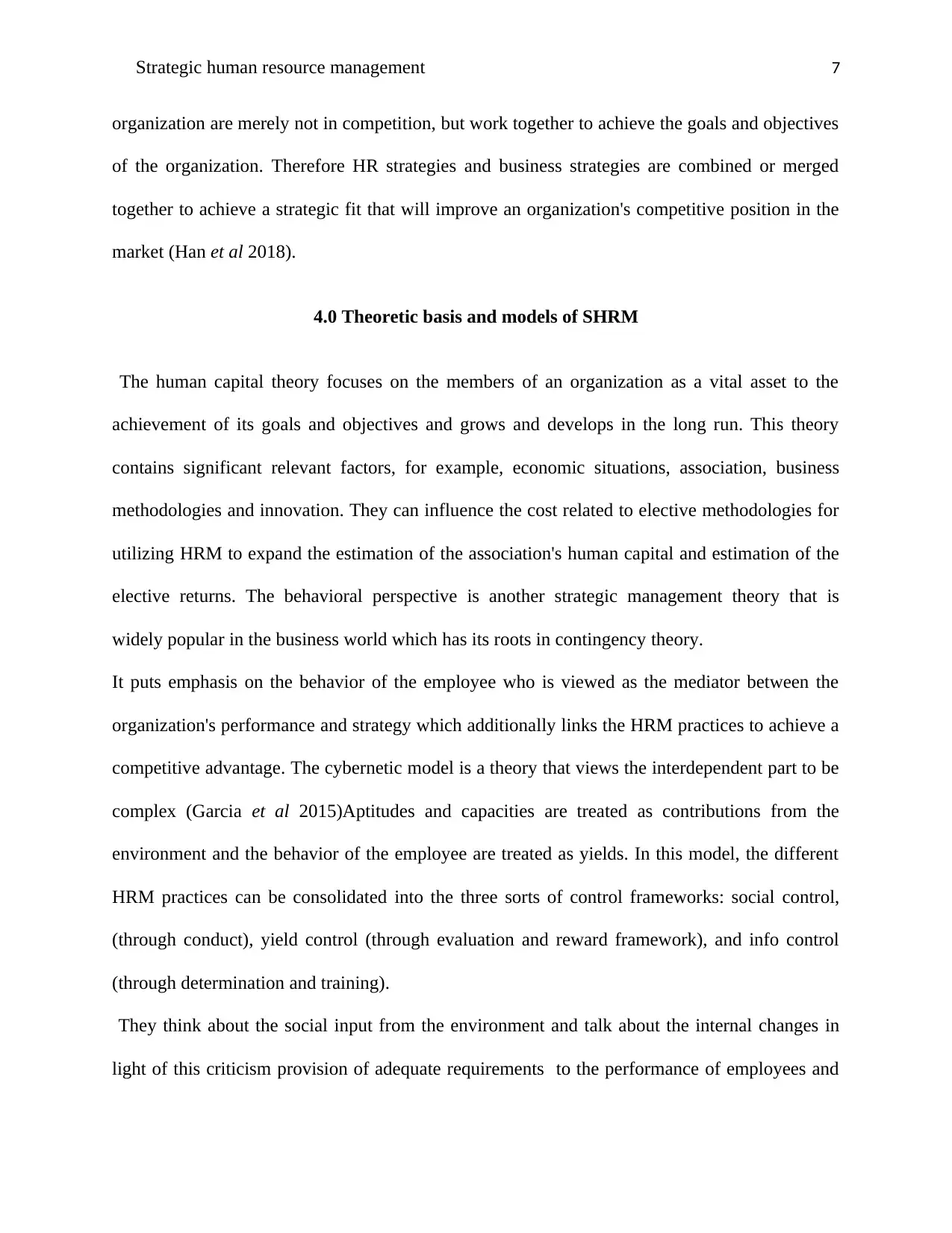
Strategic human resource management 7
organization are merely not in competition, but work together to achieve the goals and objectives
of the organization. Therefore HR strategies and business strategies are combined or merged
together to achieve a strategic fit that will improve an organization's competitive position in the
market (Han et al 2018).
4.0 Theoretic basis and models of SHRM
The human capital theory focuses on the members of an organization as a vital asset to the
achievement of its goals and objectives and grows and develops in the long run. This theory
contains significant relevant factors, for example, economic situations, association, business
methodologies and innovation. They can influence the cost related to elective methodologies for
utilizing HRM to expand the estimation of the association's human capital and estimation of the
elective returns. The behavioral perspective is another strategic management theory that is
widely popular in the business world which has its roots in contingency theory.
It puts emphasis on the behavior of the employee who is viewed as the mediator between the
organization's performance and strategy which additionally links the HRM practices to achieve a
competitive advantage. The cybernetic model is a theory that views the interdependent part to be
complex (Garcia et al 2015)Aptitudes and capacities are treated as contributions from the
environment and the behavior of the employee are treated as yields. In this model, the different
HRM practices can be consolidated into the three sorts of control frameworks: social control,
(through conduct), yield control (through evaluation and reward framework), and info control
(through determination and training).
They think about the social input from the environment and talk about the internal changes in
light of this criticism provision of adequate requirements to the performance of employees and
organization are merely not in competition, but work together to achieve the goals and objectives
of the organization. Therefore HR strategies and business strategies are combined or merged
together to achieve a strategic fit that will improve an organization's competitive position in the
market (Han et al 2018).
4.0 Theoretic basis and models of SHRM
The human capital theory focuses on the members of an organization as a vital asset to the
achievement of its goals and objectives and grows and develops in the long run. This theory
contains significant relevant factors, for example, economic situations, association, business
methodologies and innovation. They can influence the cost related to elective methodologies for
utilizing HRM to expand the estimation of the association's human capital and estimation of the
elective returns. The behavioral perspective is another strategic management theory that is
widely popular in the business world which has its roots in contingency theory.
It puts emphasis on the behavior of the employee who is viewed as the mediator between the
organization's performance and strategy which additionally links the HRM practices to achieve a
competitive advantage. The cybernetic model is a theory that views the interdependent part to be
complex (Garcia et al 2015)Aptitudes and capacities are treated as contributions from the
environment and the behavior of the employee are treated as yields. In this model, the different
HRM practices can be consolidated into the three sorts of control frameworks: social control,
(through conduct), yield control (through evaluation and reward framework), and info control
(through determination and training).
They think about the social input from the environment and talk about the internal changes in
light of this criticism provision of adequate requirements to the performance of employees and
Paraphrase This Document
Need a fresh take? Get an instant paraphrase of this document with our AI Paraphraser
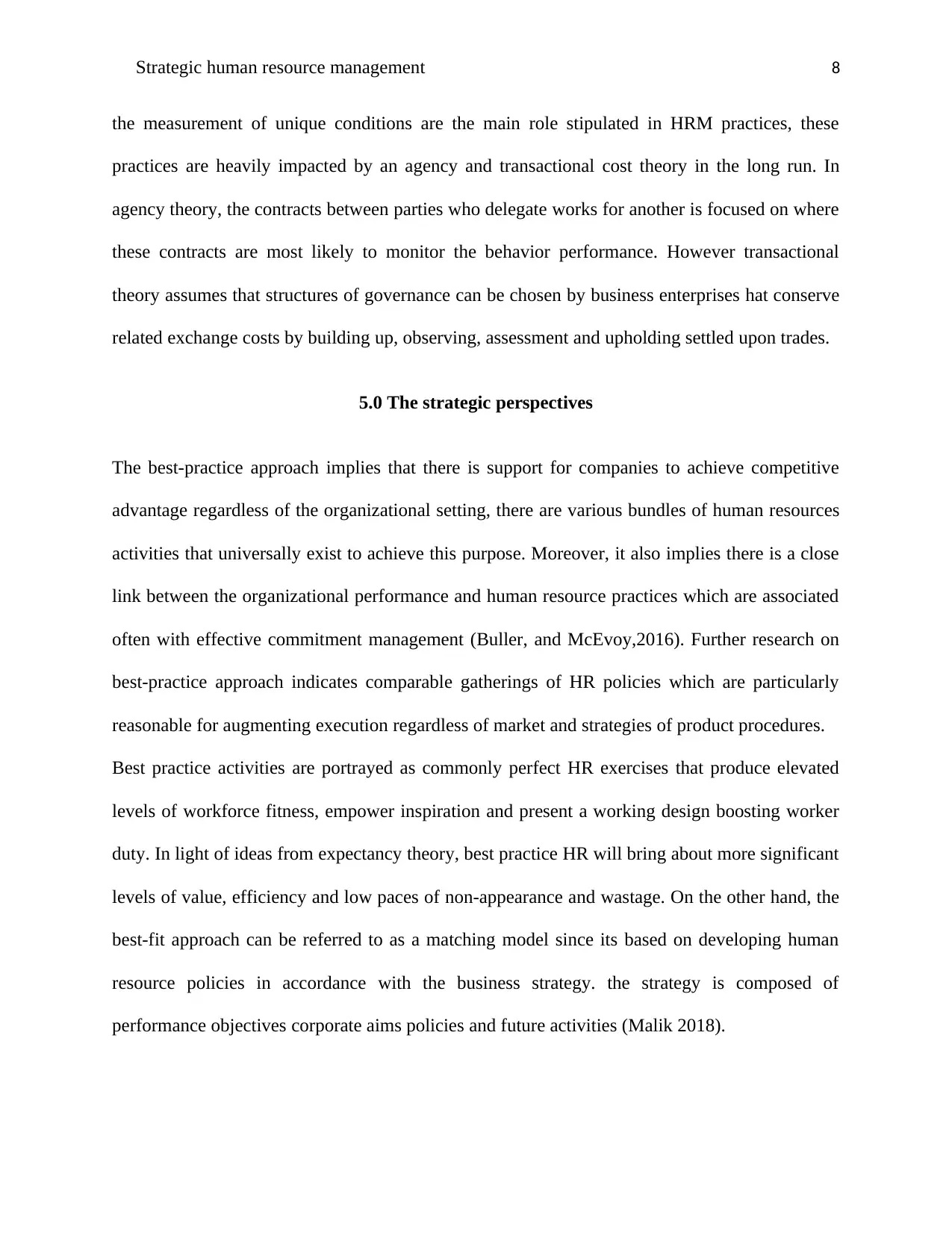
Strategic human resource management 8
the measurement of unique conditions are the main role stipulated in HRM practices, these
practices are heavily impacted by an agency and transactional cost theory in the long run. In
agency theory, the contracts between parties who delegate works for another is focused on where
these contracts are most likely to monitor the behavior performance. However transactional
theory assumes that structures of governance can be chosen by business enterprises hat conserve
related exchange costs by building up, observing, assessment and upholding settled upon trades.
5.0 The strategic perspectives
The best-practice approach implies that there is support for companies to achieve competitive
advantage regardless of the organizational setting, there are various bundles of human resources
activities that universally exist to achieve this purpose. Moreover, it also implies there is a close
link between the organizational performance and human resource practices which are associated
often with effective commitment management (Buller, and McEvoy,2016). Further research on
best-practice approach indicates comparable gatherings of HR policies which are particularly
reasonable for augmenting execution regardless of market and strategies of product procedures.
Best practice activities are portrayed as commonly perfect HR exercises that produce elevated
levels of workforce fitness, empower inspiration and present a working design boosting worker
duty. In light of ideas from expectancy theory, best practice HR will bring about more significant
levels of value, efficiency and low paces of non-appearance and wastage. On the other hand, the
best-fit approach can be referred to as a matching model since its based on developing human
resource policies in accordance with the business strategy. the strategy is composed of
performance objectives corporate aims policies and future activities (Malik 2018).
the measurement of unique conditions are the main role stipulated in HRM practices, these
practices are heavily impacted by an agency and transactional cost theory in the long run. In
agency theory, the contracts between parties who delegate works for another is focused on where
these contracts are most likely to monitor the behavior performance. However transactional
theory assumes that structures of governance can be chosen by business enterprises hat conserve
related exchange costs by building up, observing, assessment and upholding settled upon trades.
5.0 The strategic perspectives
The best-practice approach implies that there is support for companies to achieve competitive
advantage regardless of the organizational setting, there are various bundles of human resources
activities that universally exist to achieve this purpose. Moreover, it also implies there is a close
link between the organizational performance and human resource practices which are associated
often with effective commitment management (Buller, and McEvoy,2016). Further research on
best-practice approach indicates comparable gatherings of HR policies which are particularly
reasonable for augmenting execution regardless of market and strategies of product procedures.
Best practice activities are portrayed as commonly perfect HR exercises that produce elevated
levels of workforce fitness, empower inspiration and present a working design boosting worker
duty. In light of ideas from expectancy theory, best practice HR will bring about more significant
levels of value, efficiency and low paces of non-appearance and wastage. On the other hand, the
best-fit approach can be referred to as a matching model since its based on developing human
resource policies in accordance with the business strategy. the strategy is composed of
performance objectives corporate aims policies and future activities (Malik 2018).
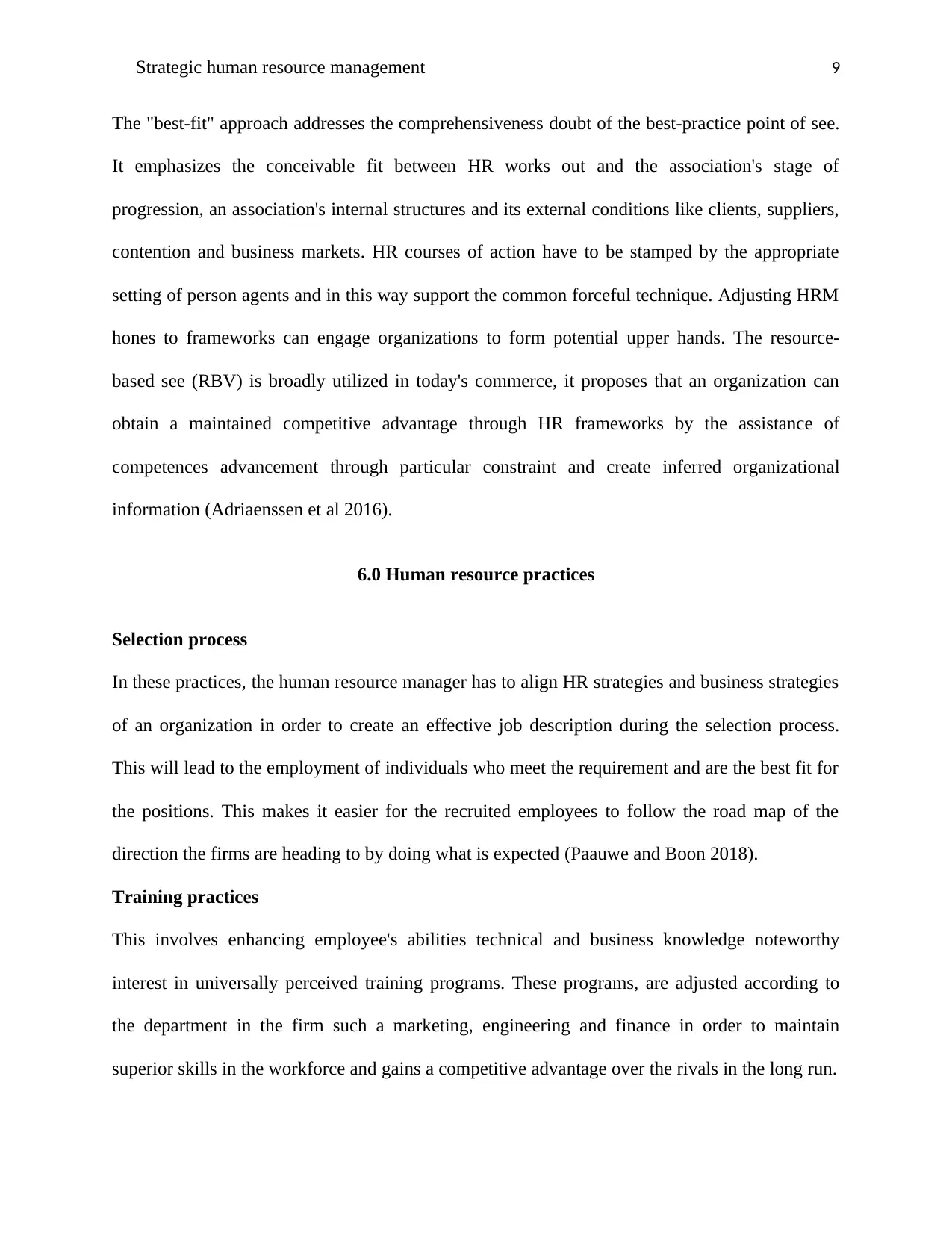
Strategic human resource management 9
The "best-fit" approach addresses the comprehensiveness doubt of the best-practice point of see.
It emphasizes the conceivable fit between HR works out and the association's stage of
progression, an association's internal structures and its external conditions like clients, suppliers,
contention and business markets. HR courses of action have to be stamped by the appropriate
setting of person agents and in this way support the common forceful technique. Adjusting HRM
hones to frameworks can engage organizations to form potential upper hands. The resource-
based see (RBV) is broadly utilized in today's commerce, it proposes that an organization can
obtain a maintained competitive advantage through HR frameworks by the assistance of
competences advancement through particular constraint and create inferred organizational
information (Adriaenssen et al 2016).
6.0 Human resource practices
Selection process
In these practices, the human resource manager has to align HR strategies and business strategies
of an organization in order to create an effective job description during the selection process.
This will lead to the employment of individuals who meet the requirement and are the best fit for
the positions. This makes it easier for the recruited employees to follow the road map of the
direction the firms are heading to by doing what is expected (Paauwe and Boon 2018).
Training practices
This involves enhancing employee's abilities technical and business knowledge noteworthy
interest in universally perceived training programs. These programs, are adjusted according to
the department in the firm such a marketing, engineering and finance in order to maintain
superior skills in the workforce and gains a competitive advantage over the rivals in the long run.
The "best-fit" approach addresses the comprehensiveness doubt of the best-practice point of see.
It emphasizes the conceivable fit between HR works out and the association's stage of
progression, an association's internal structures and its external conditions like clients, suppliers,
contention and business markets. HR courses of action have to be stamped by the appropriate
setting of person agents and in this way support the common forceful technique. Adjusting HRM
hones to frameworks can engage organizations to form potential upper hands. The resource-
based see (RBV) is broadly utilized in today's commerce, it proposes that an organization can
obtain a maintained competitive advantage through HR frameworks by the assistance of
competences advancement through particular constraint and create inferred organizational
information (Adriaenssen et al 2016).
6.0 Human resource practices
Selection process
In these practices, the human resource manager has to align HR strategies and business strategies
of an organization in order to create an effective job description during the selection process.
This will lead to the employment of individuals who meet the requirement and are the best fit for
the positions. This makes it easier for the recruited employees to follow the road map of the
direction the firms are heading to by doing what is expected (Paauwe and Boon 2018).
Training practices
This involves enhancing employee's abilities technical and business knowledge noteworthy
interest in universally perceived training programs. These programs, are adjusted according to
the department in the firm such a marketing, engineering and finance in order to maintain
superior skills in the workforce and gains a competitive advantage over the rivals in the long run.
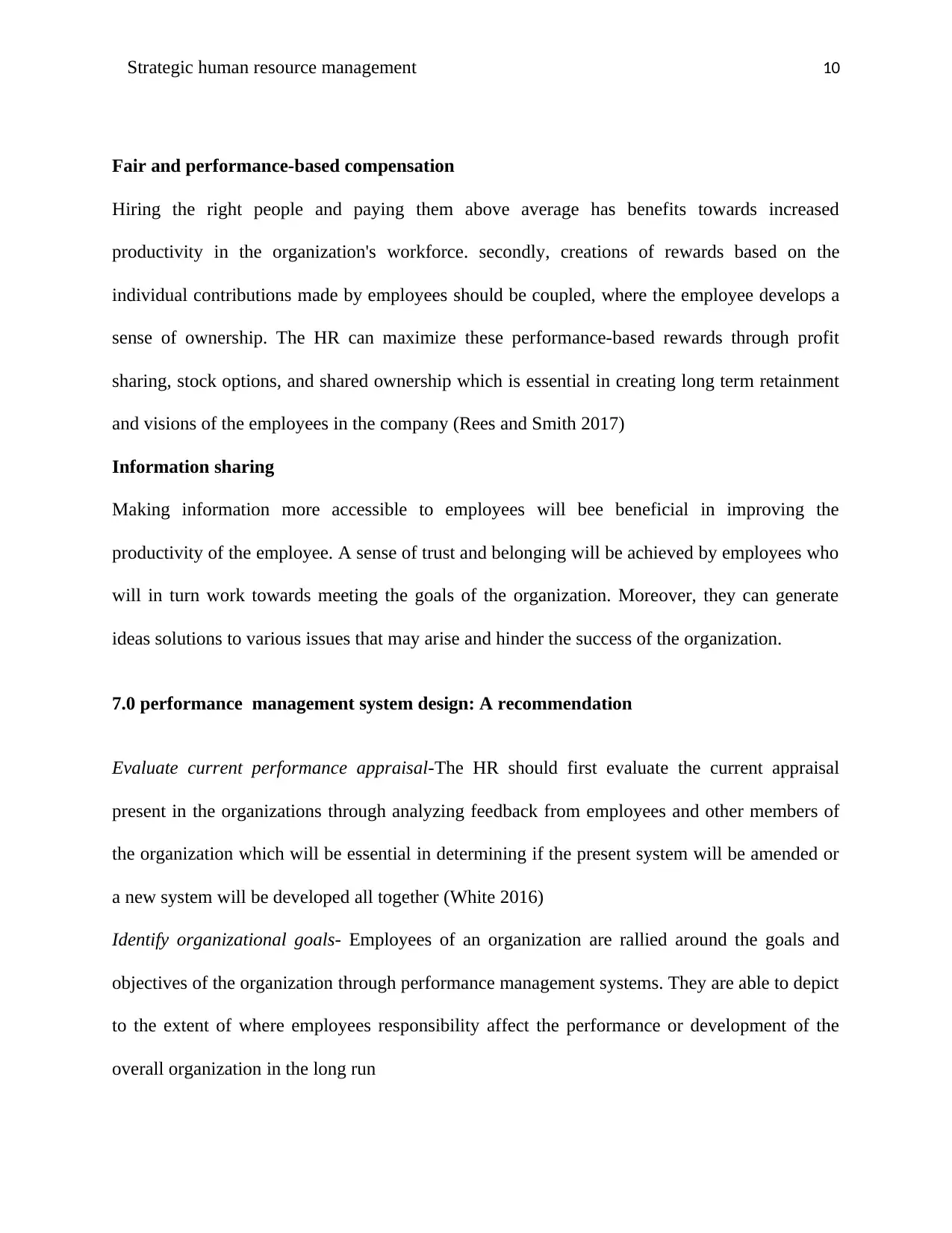
Strategic human resource management 10
Fair and performance-based compensation
Hiring the right people and paying them above average has benefits towards increased
productivity in the organization's workforce. secondly, creations of rewards based on the
individual contributions made by employees should be coupled, where the employee develops a
sense of ownership. The HR can maximize these performance-based rewards through profit
sharing, stock options, and shared ownership which is essential in creating long term retainment
and visions of the employees in the company (Rees and Smith 2017)
Information sharing
Making information more accessible to employees will bee beneficial in improving the
productivity of the employee. A sense of trust and belonging will be achieved by employees who
will in turn work towards meeting the goals of the organization. Moreover, they can generate
ideas solutions to various issues that may arise and hinder the success of the organization.
7.0 performance management system design: A recommendation
Evaluate current performance appraisal-The HR should first evaluate the current appraisal
present in the organizations through analyzing feedback from employees and other members of
the organization which will be essential in determining if the present system will be amended or
a new system will be developed all together (White 2016)
Identify organizational goals- Employees of an organization are rallied around the goals and
objectives of the organization through performance management systems. They are able to depict
to the extent of where employees responsibility affect the performance or development of the
overall organization in the long run
Fair and performance-based compensation
Hiring the right people and paying them above average has benefits towards increased
productivity in the organization's workforce. secondly, creations of rewards based on the
individual contributions made by employees should be coupled, where the employee develops a
sense of ownership. The HR can maximize these performance-based rewards through profit
sharing, stock options, and shared ownership which is essential in creating long term retainment
and visions of the employees in the company (Rees and Smith 2017)
Information sharing
Making information more accessible to employees will bee beneficial in improving the
productivity of the employee. A sense of trust and belonging will be achieved by employees who
will in turn work towards meeting the goals of the organization. Moreover, they can generate
ideas solutions to various issues that may arise and hinder the success of the organization.
7.0 performance management system design: A recommendation
Evaluate current performance appraisal-The HR should first evaluate the current appraisal
present in the organizations through analyzing feedback from employees and other members of
the organization which will be essential in determining if the present system will be amended or
a new system will be developed all together (White 2016)
Identify organizational goals- Employees of an organization are rallied around the goals and
objectives of the organization through performance management systems. They are able to depict
to the extent of where employees responsibility affect the performance or development of the
overall organization in the long run
Secure Best Marks with AI Grader
Need help grading? Try our AI Grader for instant feedback on your assignments.
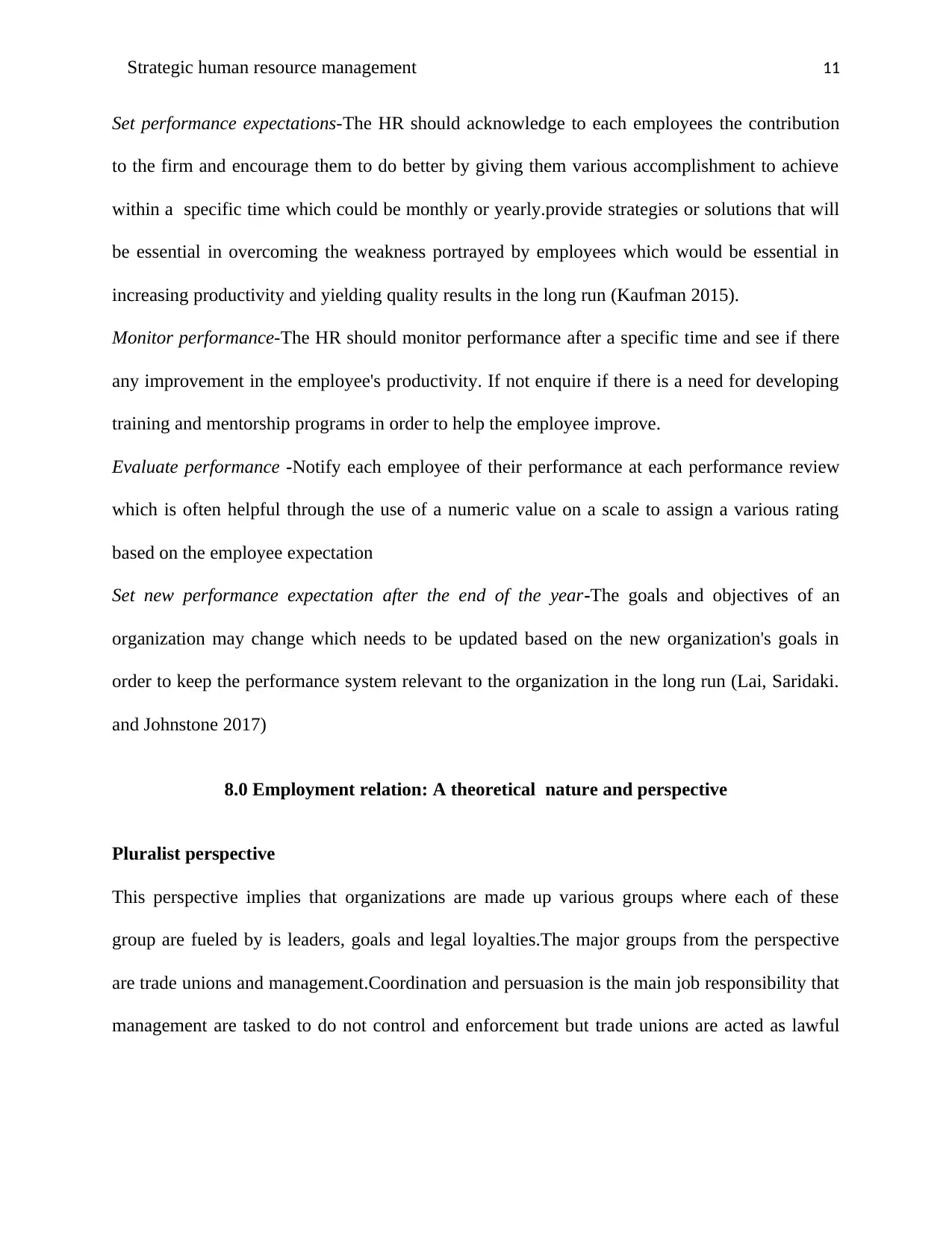
Strategic human resource management 11
Set performance expectations-The HR should acknowledge to each employees the contribution
to the firm and encourage them to do better by giving them various accomplishment to achieve
within a specific time which could be monthly or yearly.provide strategies or solutions that will
be essential in overcoming the weakness portrayed by employees which would be essential in
increasing productivity and yielding quality results in the long run (Kaufman 2015).
Monitor performance-The HR should monitor performance after a specific time and see if there
any improvement in the employee's productivity. If not enquire if there is a need for developing
training and mentorship programs in order to help the employee improve.
Evaluate performance -Notify each employee of their performance at each performance review
which is often helpful through the use of a numeric value on a scale to assign a various rating
based on the employee expectation
Set new performance expectation after the end of the year-The goals and objectives of an
organization may change which needs to be updated based on the new organization's goals in
order to keep the performance system relevant to the organization in the long run (Lai, Saridaki.
and Johnstone 2017)
8.0 Employment relation: A theoretical nature and perspective
Pluralist perspective
This perspective implies that organizations are made up various groups where each of these
group are fueled by is leaders, goals and legal loyalties.The major groups from the perspective
are trade unions and management.Coordination and persuasion is the main job responsibility that
management are tasked to do not control and enforcement but trade unions are acted as lawful
Set performance expectations-The HR should acknowledge to each employees the contribution
to the firm and encourage them to do better by giving them various accomplishment to achieve
within a specific time which could be monthly or yearly.provide strategies or solutions that will
be essential in overcoming the weakness portrayed by employees which would be essential in
increasing productivity and yielding quality results in the long run (Kaufman 2015).
Monitor performance-The HR should monitor performance after a specific time and see if there
any improvement in the employee's productivity. If not enquire if there is a need for developing
training and mentorship programs in order to help the employee improve.
Evaluate performance -Notify each employee of their performance at each performance review
which is often helpful through the use of a numeric value on a scale to assign a various rating
based on the employee expectation
Set new performance expectation after the end of the year-The goals and objectives of an
organization may change which needs to be updated based on the new organization's goals in
order to keep the performance system relevant to the organization in the long run (Lai, Saridaki.
and Johnstone 2017)
8.0 Employment relation: A theoretical nature and perspective
Pluralist perspective
This perspective implies that organizations are made up various groups where each of these
group are fueled by is leaders, goals and legal loyalties.The major groups from the perspective
are trade unions and management.Coordination and persuasion is the main job responsibility that
management are tasked to do not control and enforcement but trade unions are acted as lawful
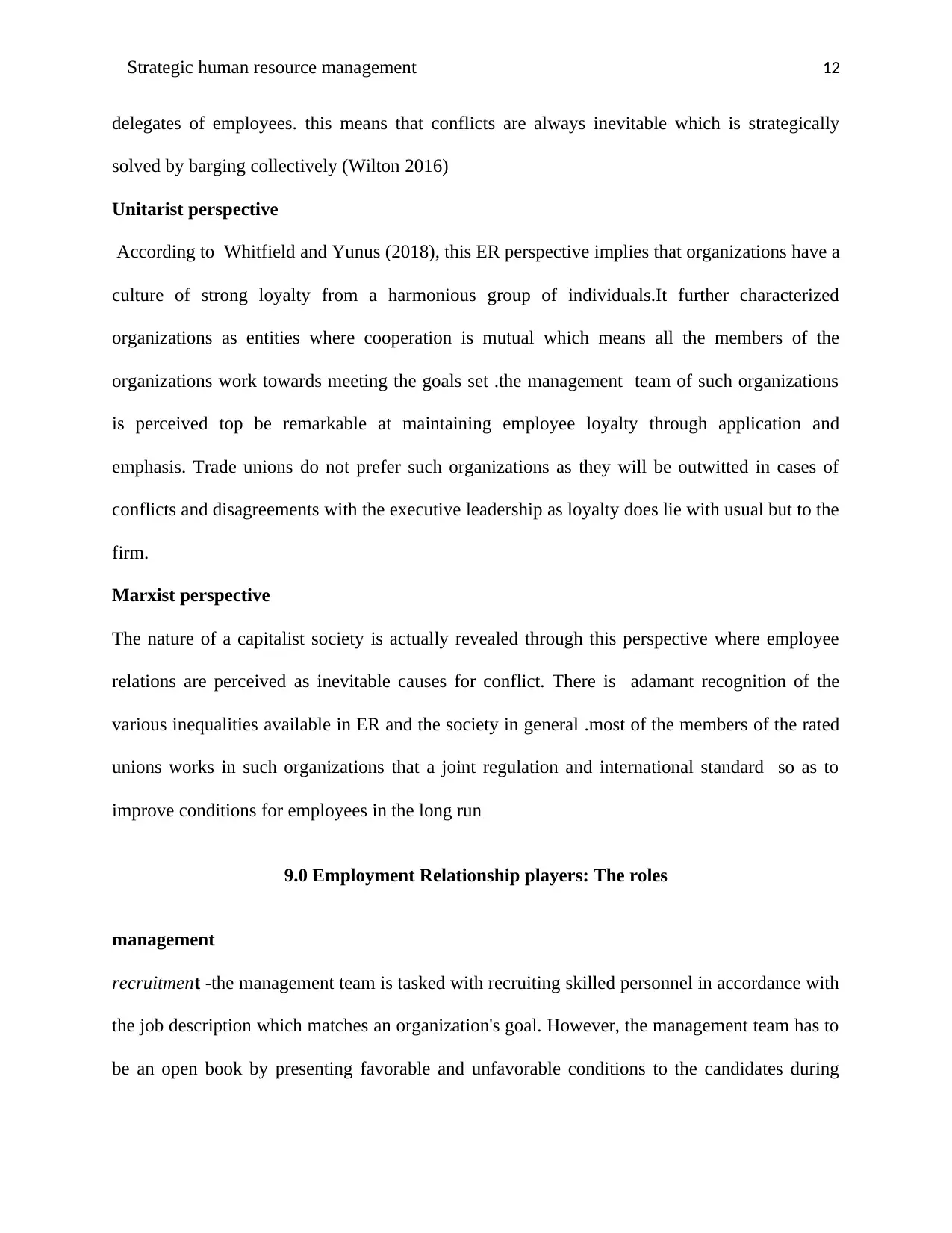
Strategic human resource management 12
delegates of employees. this means that conflicts are always inevitable which is strategically
solved by barging collectively (Wilton 2016)
Unitarist perspective
According to Whitfield and Yunus (2018), this ER perspective implies that organizations have a
culture of strong loyalty from a harmonious group of individuals.It further characterized
organizations as entities where cooperation is mutual which means all the members of the
organizations work towards meeting the goals set .the management team of such organizations
is perceived top be remarkable at maintaining employee loyalty through application and
emphasis. Trade unions do not prefer such organizations as they will be outwitted in cases of
conflicts and disagreements with the executive leadership as loyalty does lie with usual but to the
firm.
Marxist perspective
The nature of a capitalist society is actually revealed through this perspective where employee
relations are perceived as inevitable causes for conflict. There is adamant recognition of the
various inequalities available in ER and the society in general .most of the members of the rated
unions works in such organizations that a joint regulation and international standard so as to
improve conditions for employees in the long run
9.0 Employment Relationship players: The roles
management
recruitment -the management team is tasked with recruiting skilled personnel in accordance with
the job description which matches an organization's goal. However, the management team has to
be an open book by presenting favorable and unfavorable conditions to the candidates during
delegates of employees. this means that conflicts are always inevitable which is strategically
solved by barging collectively (Wilton 2016)
Unitarist perspective
According to Whitfield and Yunus (2018), this ER perspective implies that organizations have a
culture of strong loyalty from a harmonious group of individuals.It further characterized
organizations as entities where cooperation is mutual which means all the members of the
organizations work towards meeting the goals set .the management team of such organizations
is perceived top be remarkable at maintaining employee loyalty through application and
emphasis. Trade unions do not prefer such organizations as they will be outwitted in cases of
conflicts and disagreements with the executive leadership as loyalty does lie with usual but to the
firm.
Marxist perspective
The nature of a capitalist society is actually revealed through this perspective where employee
relations are perceived as inevitable causes for conflict. There is adamant recognition of the
various inequalities available in ER and the society in general .most of the members of the rated
unions works in such organizations that a joint regulation and international standard so as to
improve conditions for employees in the long run
9.0 Employment Relationship players: The roles
management
recruitment -the management team is tasked with recruiting skilled personnel in accordance with
the job description which matches an organization's goal. However, the management team has to
be an open book by presenting favorable and unfavorable conditions to the candidates during
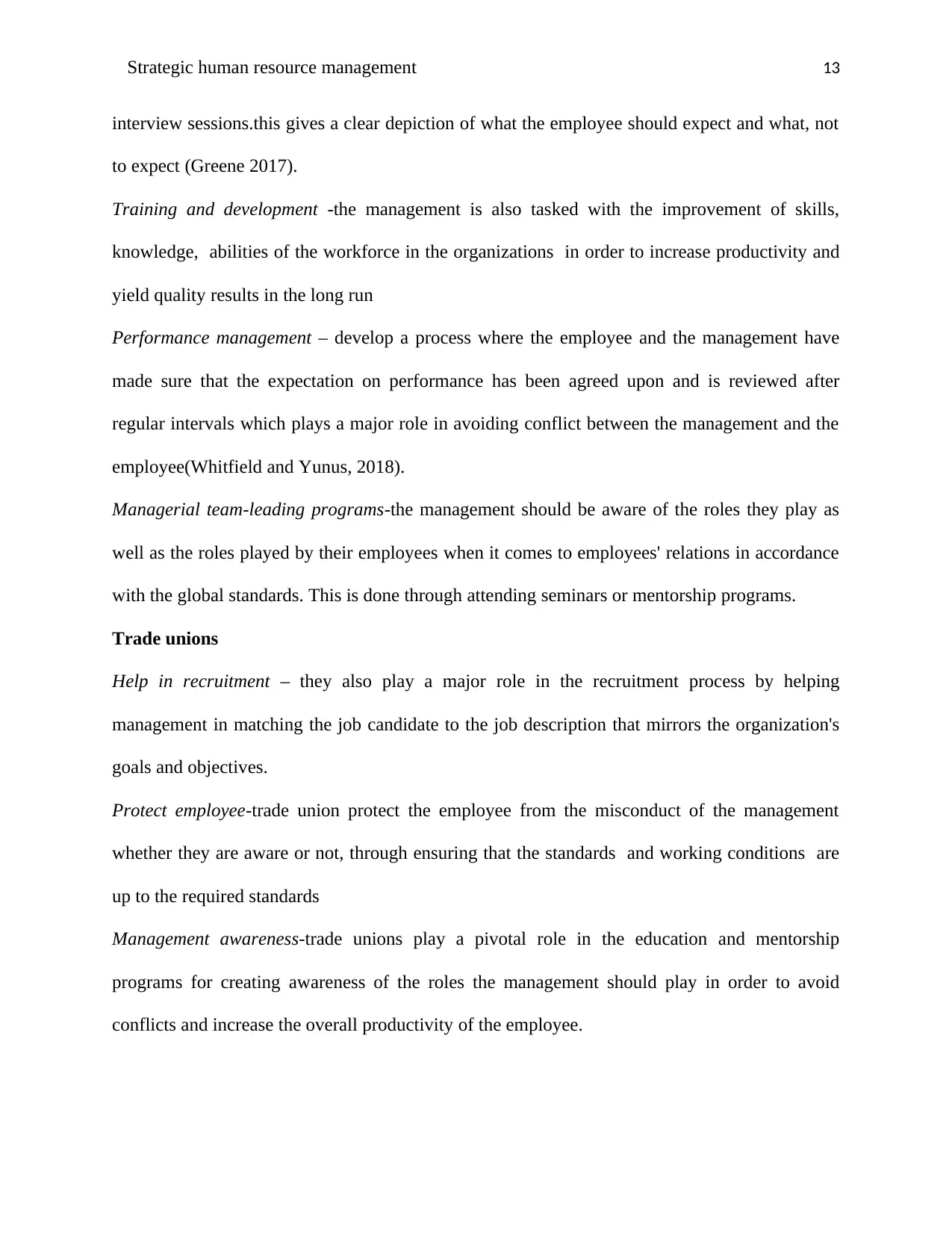
Strategic human resource management 13
interview sessions.this gives a clear depiction of what the employee should expect and what, not
to expect (Greene 2017).
Training and development -the management is also tasked with the improvement of skills,
knowledge, abilities of the workforce in the organizations in order to increase productivity and
yield quality results in the long run
Performance management – develop a process where the employee and the management have
made sure that the expectation on performance has been agreed upon and is reviewed after
regular intervals which plays a major role in avoiding conflict between the management and the
employee(Whitfield and Yunus, 2018).
Managerial team-leading programs-the management should be aware of the roles they play as
well as the roles played by their employees when it comes to employees' relations in accordance
with the global standards. This is done through attending seminars or mentorship programs.
Trade unions
Help in recruitment – they also play a major role in the recruitment process by helping
management in matching the job candidate to the job description that mirrors the organization's
goals and objectives.
Protect employee-trade union protect the employee from the misconduct of the management
whether they are aware or not, through ensuring that the standards and working conditions are
up to the required standards
Management awareness-trade unions play a pivotal role in the education and mentorship
programs for creating awareness of the roles the management should play in order to avoid
conflicts and increase the overall productivity of the employee.
interview sessions.this gives a clear depiction of what the employee should expect and what, not
to expect (Greene 2017).
Training and development -the management is also tasked with the improvement of skills,
knowledge, abilities of the workforce in the organizations in order to increase productivity and
yield quality results in the long run
Performance management – develop a process where the employee and the management have
made sure that the expectation on performance has been agreed upon and is reviewed after
regular intervals which plays a major role in avoiding conflict between the management and the
employee(Whitfield and Yunus, 2018).
Managerial team-leading programs-the management should be aware of the roles they play as
well as the roles played by their employees when it comes to employees' relations in accordance
with the global standards. This is done through attending seminars or mentorship programs.
Trade unions
Help in recruitment – they also play a major role in the recruitment process by helping
management in matching the job candidate to the job description that mirrors the organization's
goals and objectives.
Protect employee-trade union protect the employee from the misconduct of the management
whether they are aware or not, through ensuring that the standards and working conditions are
up to the required standards
Management awareness-trade unions play a pivotal role in the education and mentorship
programs for creating awareness of the roles the management should play in order to avoid
conflicts and increase the overall productivity of the employee.
Paraphrase This Document
Need a fresh take? Get an instant paraphrase of this document with our AI Paraphraser
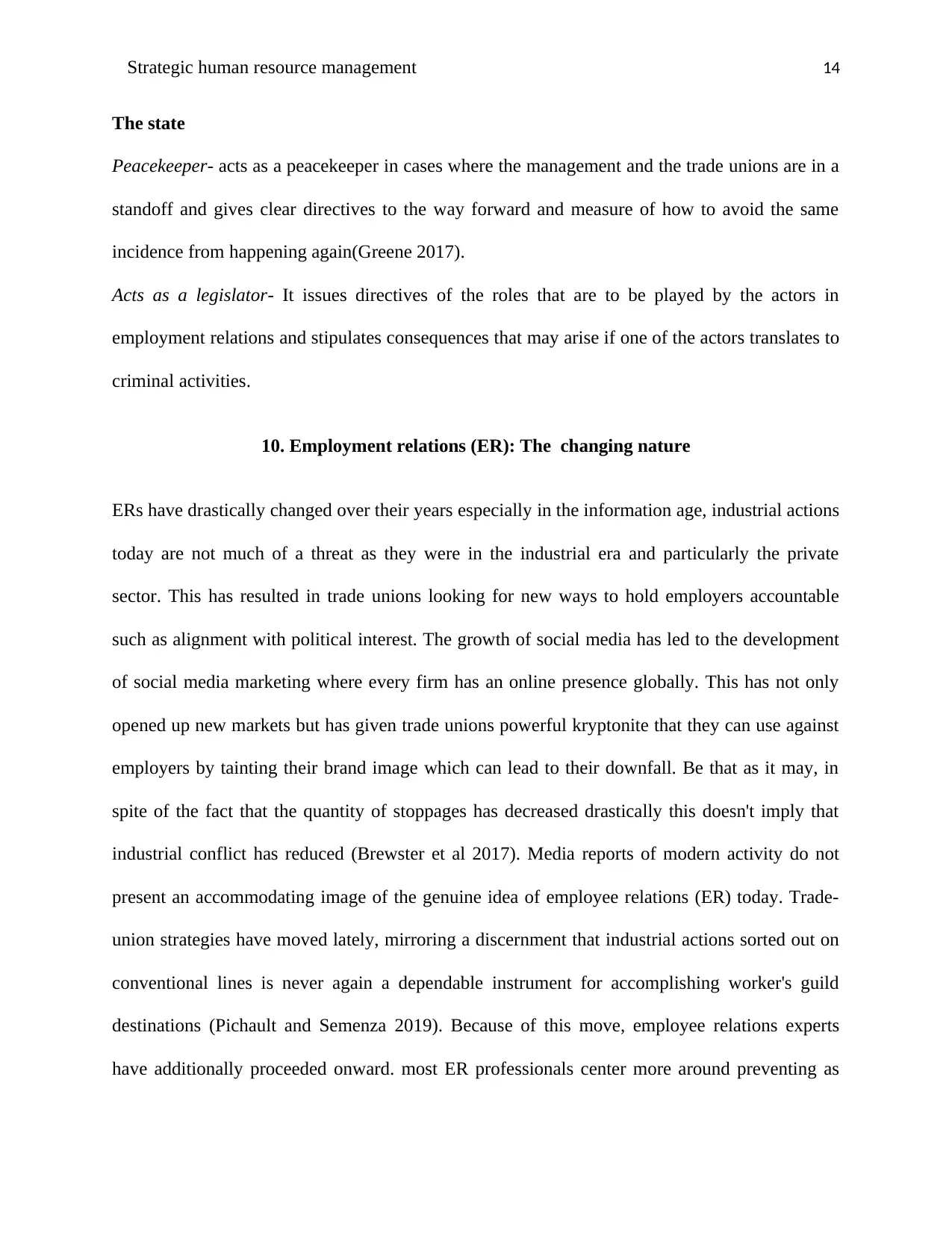
Strategic human resource management 14
The state
Peacekeeper- acts as a peacekeeper in cases where the management and the trade unions are in a
standoff and gives clear directives to the way forward and measure of how to avoid the same
incidence from happening again(Greene 2017).
Acts as a legislator- It issues directives of the roles that are to be played by the actors in
employment relations and stipulates consequences that may arise if one of the actors translates to
criminal activities.
10. Employment relations (ER): The changing nature
ERs have drastically changed over their years especially in the information age, industrial actions
today are not much of a threat as they were in the industrial era and particularly the private
sector. This has resulted in trade unions looking for new ways to hold employers accountable
such as alignment with political interest. The growth of social media has led to the development
of social media marketing where every firm has an online presence globally. This has not only
opened up new markets but has given trade unions powerful kryptonite that they can use against
employers by tainting their brand image which can lead to their downfall. Be that as it may, in
spite of the fact that the quantity of stoppages has decreased drastically this doesn't imply that
industrial conflict has reduced (Brewster et al 2017). Media reports of modern activity do not
present an accommodating image of the genuine idea of employee relations (ER) today. Trade-
union strategies have moved lately, mirroring a discernment that industrial actions sorted out on
conventional lines is never again a dependable instrument for accomplishing worker's guild
destinations (Pichault and Semenza 2019). Because of this move, employee relations experts
have additionally proceeded onward. most ER professionals center more around preventing as
The state
Peacekeeper- acts as a peacekeeper in cases where the management and the trade unions are in a
standoff and gives clear directives to the way forward and measure of how to avoid the same
incidence from happening again(Greene 2017).
Acts as a legislator- It issues directives of the roles that are to be played by the actors in
employment relations and stipulates consequences that may arise if one of the actors translates to
criminal activities.
10. Employment relations (ER): The changing nature
ERs have drastically changed over their years especially in the information age, industrial actions
today are not much of a threat as they were in the industrial era and particularly the private
sector. This has resulted in trade unions looking for new ways to hold employers accountable
such as alignment with political interest. The growth of social media has led to the development
of social media marketing where every firm has an online presence globally. This has not only
opened up new markets but has given trade unions powerful kryptonite that they can use against
employers by tainting their brand image which can lead to their downfall. Be that as it may, in
spite of the fact that the quantity of stoppages has decreased drastically this doesn't imply that
industrial conflict has reduced (Brewster et al 2017). Media reports of modern activity do not
present an accommodating image of the genuine idea of employee relations (ER) today. Trade-
union strategies have moved lately, mirroring a discernment that industrial actions sorted out on
conventional lines is never again a dependable instrument for accomplishing worker's guild
destinations (Pichault and Semenza 2019). Because of this move, employee relations experts
have additionally proceeded onward. most ER professionals center more around preventing as
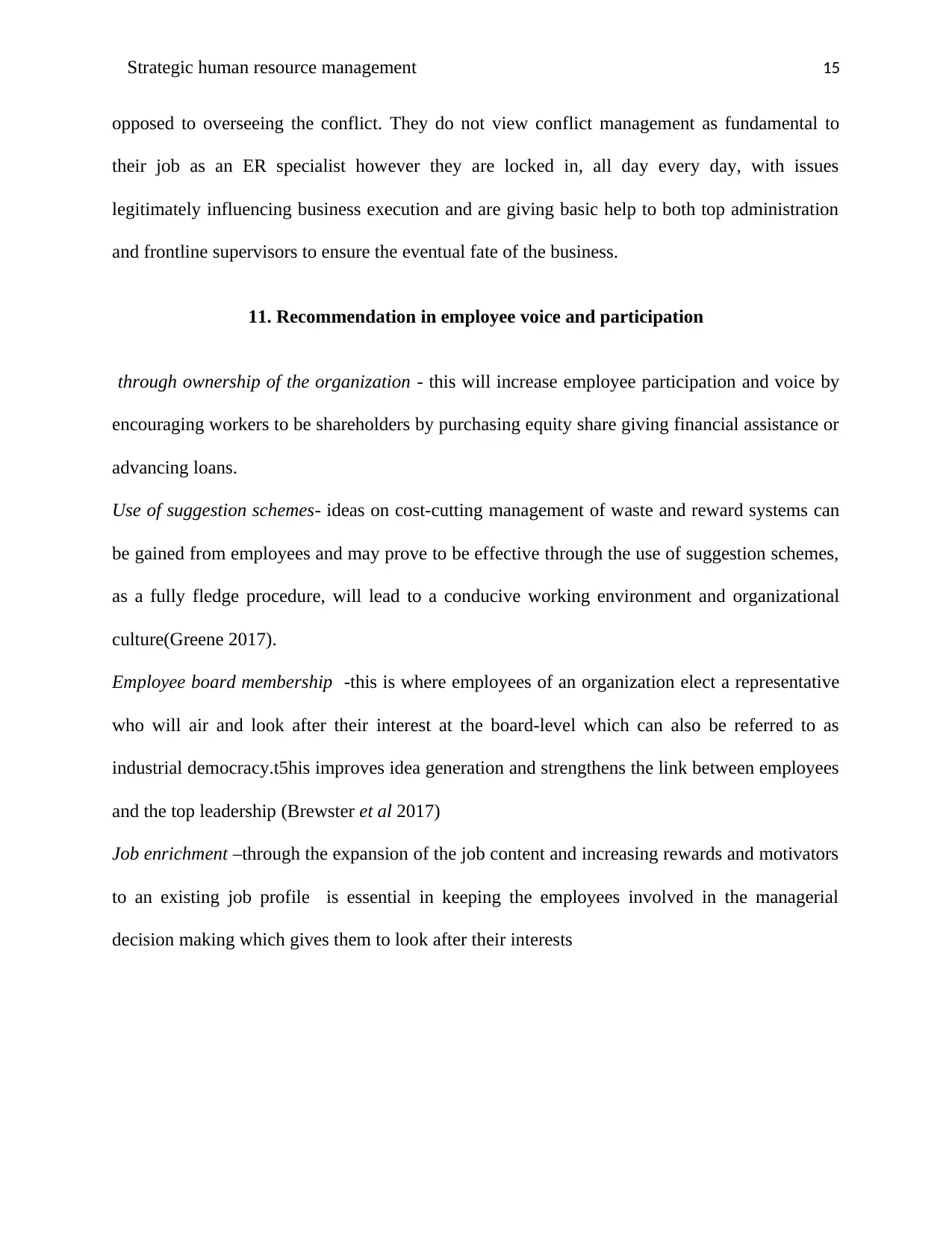
Strategic human resource management 15
opposed to overseeing the conflict. They do not view conflict management as fundamental to
their job as an ER specialist however they are locked in, all day every day, with issues
legitimately influencing business execution and are giving basic help to both top administration
and frontline supervisors to ensure the eventual fate of the business.
11. Recommendation in employee voice and participation
through ownership of the organization - this will increase employee participation and voice by
encouraging workers to be shareholders by purchasing equity share giving financial assistance or
advancing loans.
Use of suggestion schemes- ideas on cost-cutting management of waste and reward systems can
be gained from employees and may prove to be effective through the use of suggestion schemes,
as a fully fledge procedure, will lead to a conducive working environment and organizational
culture(Greene 2017).
Employee board membership -this is where employees of an organization elect a representative
who will air and look after their interest at the board-level which can also be referred to as
industrial democracy.t5his improves idea generation and strengthens the link between employees
and the top leadership (Brewster et al 2017)
Job enrichment –through the expansion of the job content and increasing rewards and motivators
to an existing job profile is essential in keeping the employees involved in the managerial
decision making which gives them to look after their interests
opposed to overseeing the conflict. They do not view conflict management as fundamental to
their job as an ER specialist however they are locked in, all day every day, with issues
legitimately influencing business execution and are giving basic help to both top administration
and frontline supervisors to ensure the eventual fate of the business.
11. Recommendation in employee voice and participation
through ownership of the organization - this will increase employee participation and voice by
encouraging workers to be shareholders by purchasing equity share giving financial assistance or
advancing loans.
Use of suggestion schemes- ideas on cost-cutting management of waste and reward systems can
be gained from employees and may prove to be effective through the use of suggestion schemes,
as a fully fledge procedure, will lead to a conducive working environment and organizational
culture(Greene 2017).
Employee board membership -this is where employees of an organization elect a representative
who will air and look after their interest at the board-level which can also be referred to as
industrial democracy.t5his improves idea generation and strengthens the link between employees
and the top leadership (Brewster et al 2017)
Job enrichment –through the expansion of the job content and increasing rewards and motivators
to an existing job profile is essential in keeping the employees involved in the managerial
decision making which gives them to look after their interests
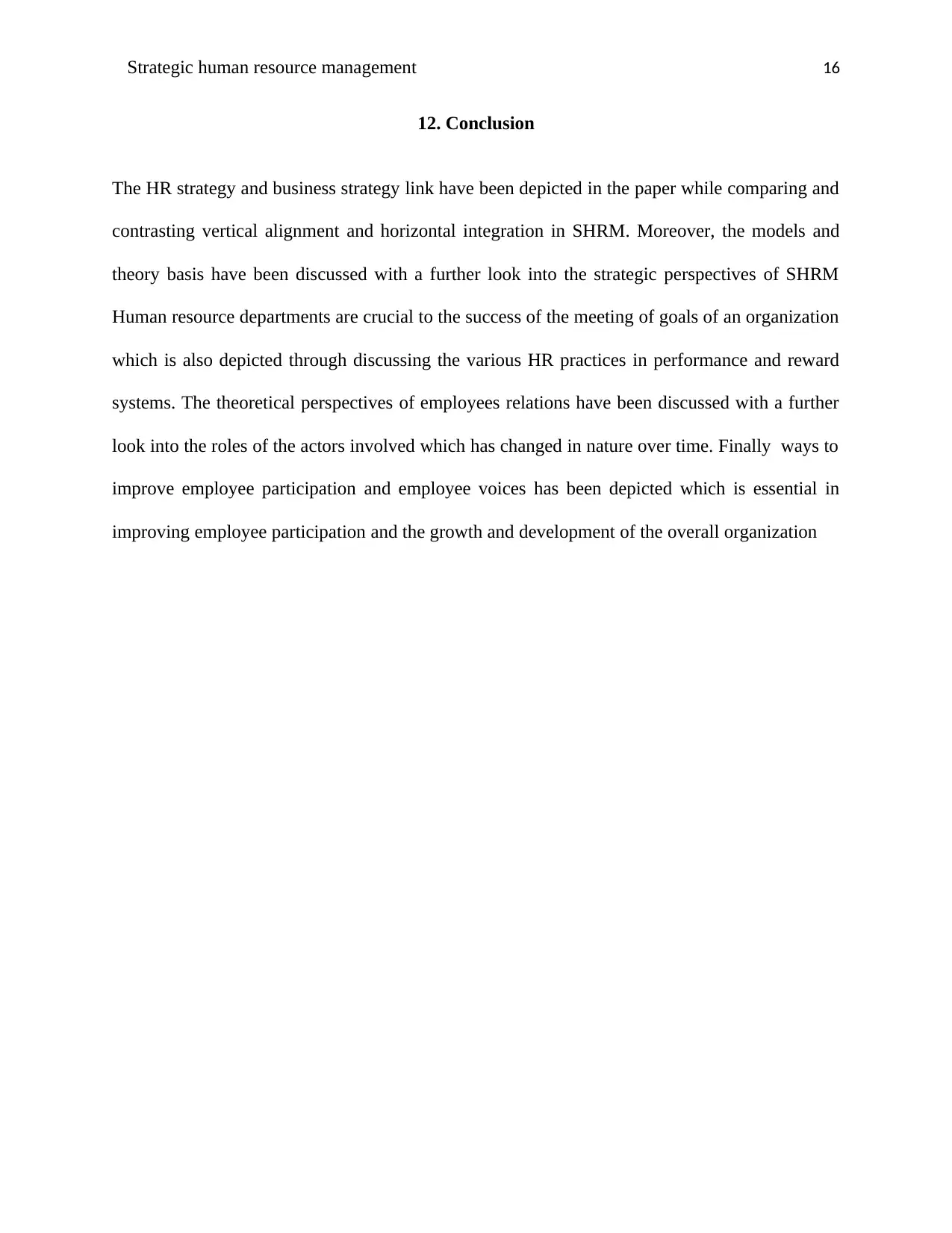
Strategic human resource management 16
12. Conclusion
The HR strategy and business strategy link have been depicted in the paper while comparing and
contrasting vertical alignment and horizontal integration in SHRM. Moreover, the models and
theory basis have been discussed with a further look into the strategic perspectives of SHRM
Human resource departments are crucial to the success of the meeting of goals of an organization
which is also depicted through discussing the various HR practices in performance and reward
systems. The theoretical perspectives of employees relations have been discussed with a further
look into the roles of the actors involved which has changed in nature over time. Finally ways to
improve employee participation and employee voices has been depicted which is essential in
improving employee participation and the growth and development of the overall organization
12. Conclusion
The HR strategy and business strategy link have been depicted in the paper while comparing and
contrasting vertical alignment and horizontal integration in SHRM. Moreover, the models and
theory basis have been discussed with a further look into the strategic perspectives of SHRM
Human resource departments are crucial to the success of the meeting of goals of an organization
which is also depicted through discussing the various HR practices in performance and reward
systems. The theoretical perspectives of employees relations have been discussed with a further
look into the roles of the actors involved which has changed in nature over time. Finally ways to
improve employee participation and employee voices has been depicted which is essential in
improving employee participation and the growth and development of the overall organization
Secure Best Marks with AI Grader
Need help grading? Try our AI Grader for instant feedback on your assignments.
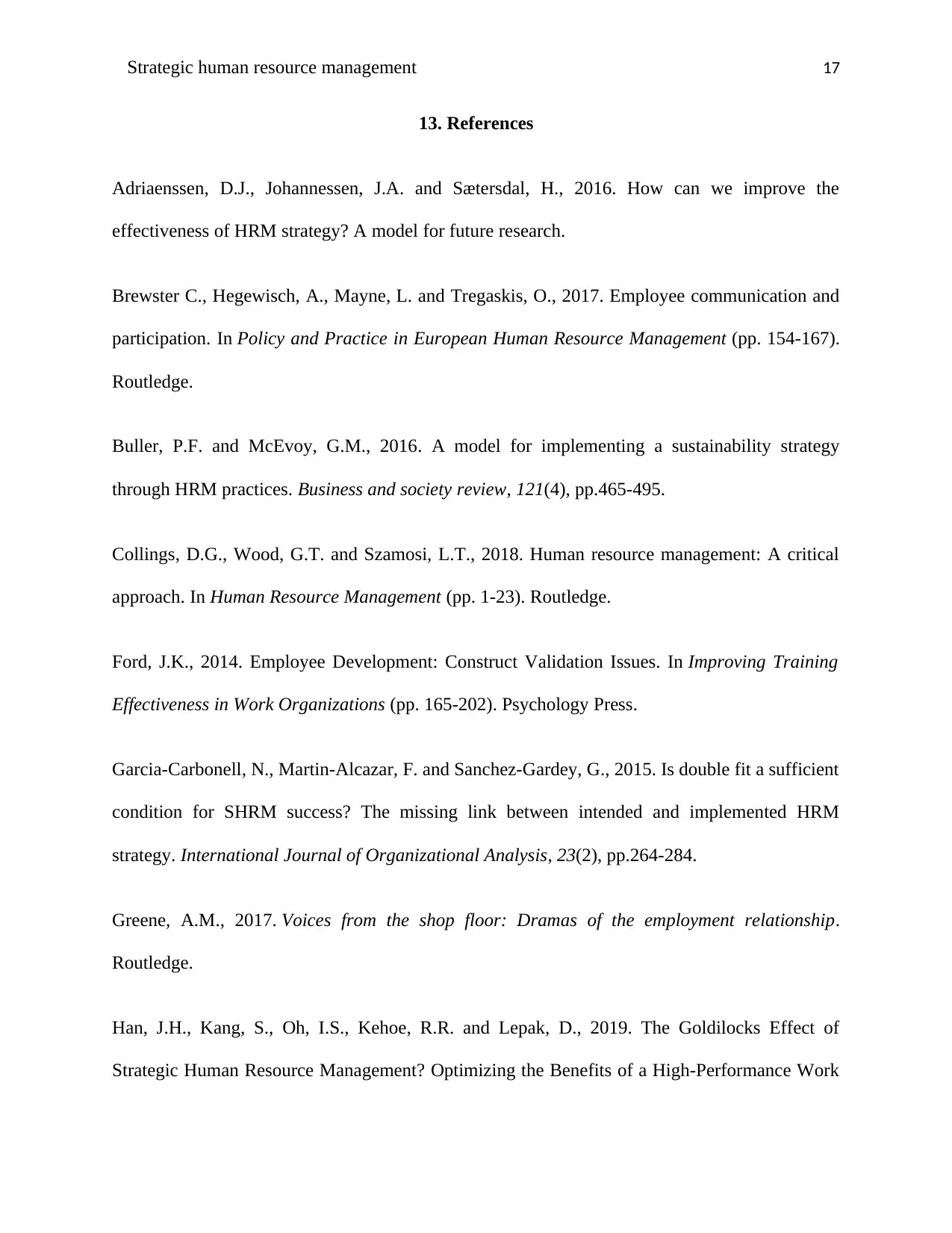
Strategic human resource management 17
13. References
Adriaenssen, D.J., Johannessen, J.A. and Sætersdal, H., 2016. How can we improve the
effectiveness of HRM strategy? A model for future research.
Brewster C., Hegewisch, A., Mayne, L. and Tregaskis, O., 2017. Employee communication and
participation. In Policy and Practice in European Human Resource Management (pp. 154-167).
Routledge.
Buller, P.F. and McEvoy, G.M., 2016. A model for implementing a sustainability strategy
through HRM practices. Business and society review, 121(4), pp.465-495.
Collings, D.G., Wood, G.T. and Szamosi, L.T., 2018. Human resource management: A critical
approach. In Human Resource Management (pp. 1-23). Routledge.
Ford, J.K., 2014. Employee Development: Construct Validation Issues. In Improving Training
Effectiveness in Work Organizations (pp. 165-202). Psychology Press.
Garcia-Carbonell, N., Martin-Alcazar, F. and Sanchez-Gardey, G., 2015. Is double fit a sufficient
condition for SHRM success? The missing link between intended and implemented HRM
strategy. International Journal of Organizational Analysis, 23(2), pp.264-284.
Greene, A.M., 2017. Voices from the shop floor: Dramas of the employment relationship.
Routledge.
Han, J.H., Kang, S., Oh, I.S., Kehoe, R.R. and Lepak, D., 2019. The Goldilocks Effect of
Strategic Human Resource Management? Optimizing the Benefits of a High-Performance Work
13. References
Adriaenssen, D.J., Johannessen, J.A. and Sætersdal, H., 2016. How can we improve the
effectiveness of HRM strategy? A model for future research.
Brewster C., Hegewisch, A., Mayne, L. and Tregaskis, O., 2017. Employee communication and
participation. In Policy and Practice in European Human Resource Management (pp. 154-167).
Routledge.
Buller, P.F. and McEvoy, G.M., 2016. A model for implementing a sustainability strategy
through HRM practices. Business and society review, 121(4), pp.465-495.
Collings, D.G., Wood, G.T. and Szamosi, L.T., 2018. Human resource management: A critical
approach. In Human Resource Management (pp. 1-23). Routledge.
Ford, J.K., 2014. Employee Development: Construct Validation Issues. In Improving Training
Effectiveness in Work Organizations (pp. 165-202). Psychology Press.
Garcia-Carbonell, N., Martin-Alcazar, F. and Sanchez-Gardey, G., 2015. Is double fit a sufficient
condition for SHRM success? The missing link between intended and implemented HRM
strategy. International Journal of Organizational Analysis, 23(2), pp.264-284.
Greene, A.M., 2017. Voices from the shop floor: Dramas of the employment relationship.
Routledge.
Han, J.H., Kang, S., Oh, I.S., Kehoe, R.R. and Lepak, D., 2019. The Goldilocks Effect of
Strategic Human Resource Management? Optimizing the Benefits of a High-Performance Work
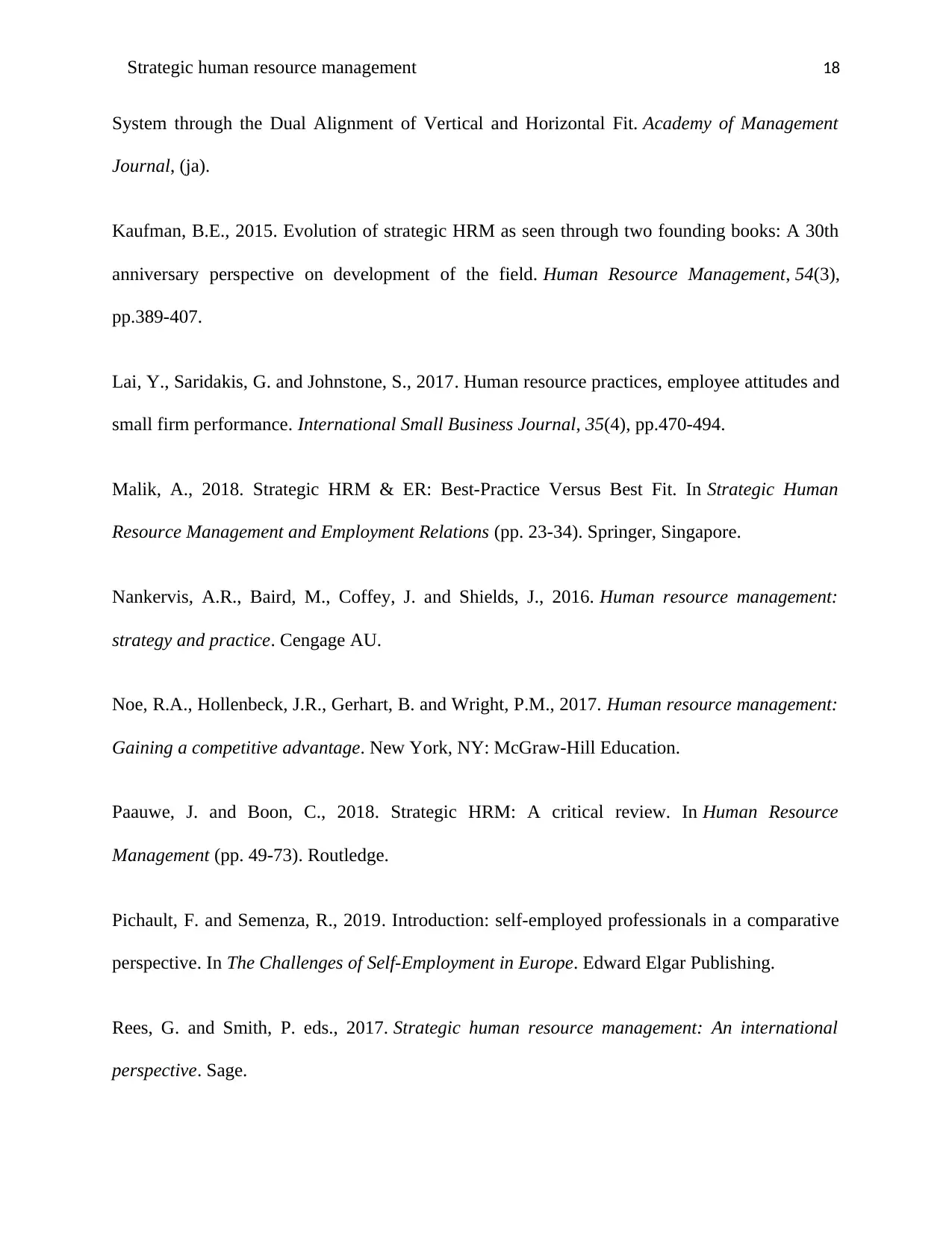
Strategic human resource management 18
System through the Dual Alignment of Vertical and Horizontal Fit. Academy of Management
Journal, (ja).
Kaufman, B.E., 2015. Evolution of strategic HRM as seen through two founding books: A 30th
anniversary perspective on development of the field. Human Resource Management, 54(3),
pp.389-407.
Lai, Y., Saridakis, G. and Johnstone, S., 2017. Human resource practices, employee attitudes and
small firm performance. International Small Business Journal, 35(4), pp.470-494.
Malik, A., 2018. Strategic HRM & ER: Best-Practice Versus Best Fit. In Strategic Human
Resource Management and Employment Relations (pp. 23-34). Springer, Singapore.
Nankervis, A.R., Baird, M., Coffey, J. and Shields, J., 2016. Human resource management:
strategy and practice. Cengage AU.
Noe, R.A., Hollenbeck, J.R., Gerhart, B. and Wright, P.M., 2017. Human resource management:
Gaining a competitive advantage. New York, NY: McGraw-Hill Education.
Paauwe, J. and Boon, C., 2018. Strategic HRM: A critical review. In Human Resource
Management (pp. 49-73). Routledge.
Pichault, F. and Semenza, R., 2019. Introduction: self-employed professionals in a comparative
perspective. In The Challenges of Self-Employment in Europe. Edward Elgar Publishing.
Rees, G. and Smith, P. eds., 2017. Strategic human resource management: An international
perspective. Sage.
System through the Dual Alignment of Vertical and Horizontal Fit. Academy of Management
Journal, (ja).
Kaufman, B.E., 2015. Evolution of strategic HRM as seen through two founding books: A 30th
anniversary perspective on development of the field. Human Resource Management, 54(3),
pp.389-407.
Lai, Y., Saridakis, G. and Johnstone, S., 2017. Human resource practices, employee attitudes and
small firm performance. International Small Business Journal, 35(4), pp.470-494.
Malik, A., 2018. Strategic HRM & ER: Best-Practice Versus Best Fit. In Strategic Human
Resource Management and Employment Relations (pp. 23-34). Springer, Singapore.
Nankervis, A.R., Baird, M., Coffey, J. and Shields, J., 2016. Human resource management:
strategy and practice. Cengage AU.
Noe, R.A., Hollenbeck, J.R., Gerhart, B. and Wright, P.M., 2017. Human resource management:
Gaining a competitive advantage. New York, NY: McGraw-Hill Education.
Paauwe, J. and Boon, C., 2018. Strategic HRM: A critical review. In Human Resource
Management (pp. 49-73). Routledge.
Pichault, F. and Semenza, R., 2019. Introduction: self-employed professionals in a comparative
perspective. In The Challenges of Self-Employment in Europe. Edward Elgar Publishing.
Rees, G. and Smith, P. eds., 2017. Strategic human resource management: An international
perspective. Sage.
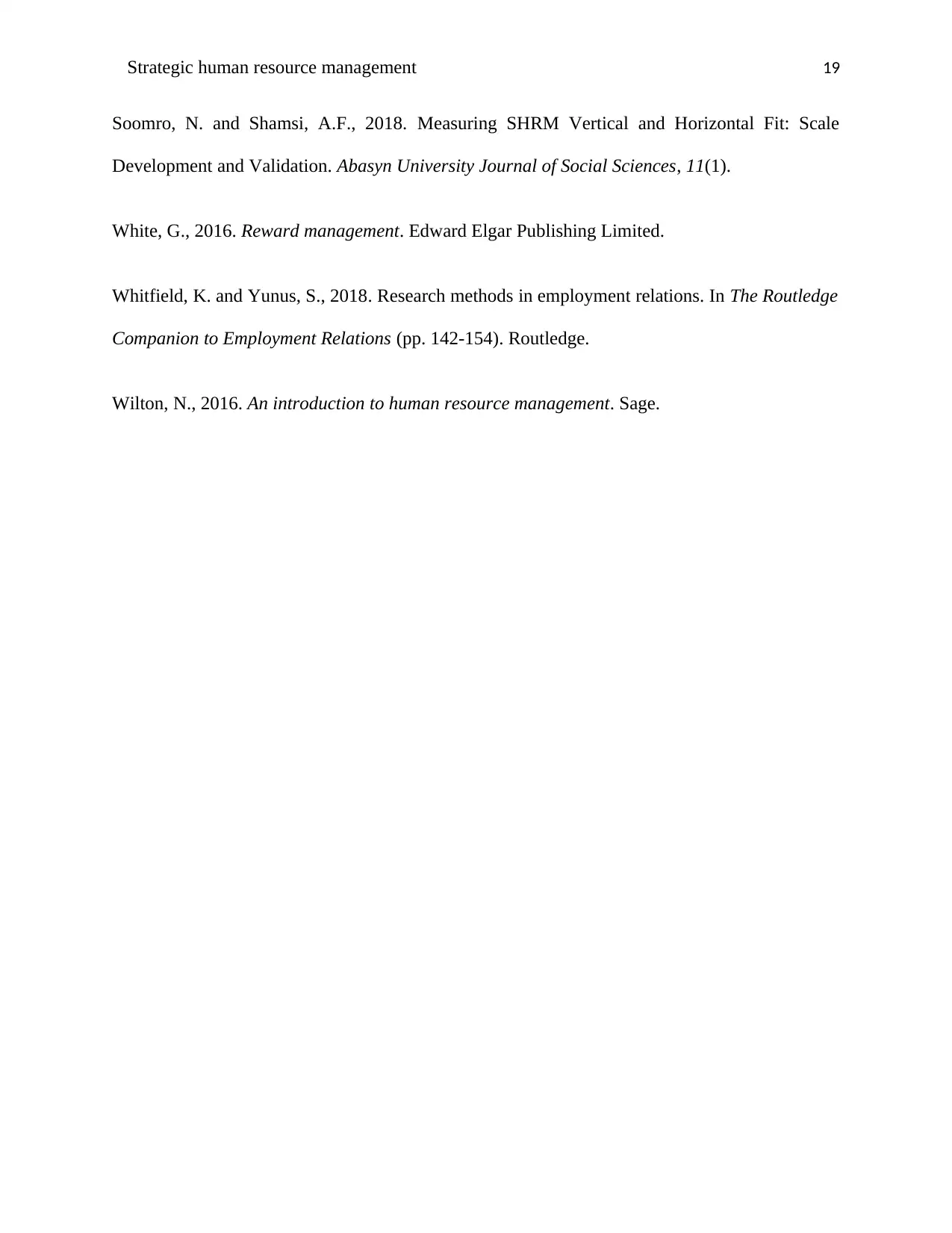
Strategic human resource management 19
Soomro, N. and Shamsi, A.F., 2018. Measuring SHRM Vertical and Horizontal Fit: Scale
Development and Validation. Abasyn University Journal of Social Sciences, 11(1).
White, G., 2016. Reward management. Edward Elgar Publishing Limited.
Whitfield, K. and Yunus, S., 2018. Research methods in employment relations. In The Routledge
Companion to Employment Relations (pp. 142-154). Routledge.
Wilton, N., 2016. An introduction to human resource management. Sage.
Soomro, N. and Shamsi, A.F., 2018. Measuring SHRM Vertical and Horizontal Fit: Scale
Development and Validation. Abasyn University Journal of Social Sciences, 11(1).
White, G., 2016. Reward management. Edward Elgar Publishing Limited.
Whitfield, K. and Yunus, S., 2018. Research methods in employment relations. In The Routledge
Companion to Employment Relations (pp. 142-154). Routledge.
Wilton, N., 2016. An introduction to human resource management. Sage.
1 out of 19
Related Documents
Your All-in-One AI-Powered Toolkit for Academic Success.
+13062052269
info@desklib.com
Available 24*7 on WhatsApp / Email
![[object Object]](/_next/static/media/star-bottom.7253800d.svg)
Unlock your academic potential
© 2024 | Zucol Services PVT LTD | All rights reserved.





